Chapter 7—
The Madrigals of Adrian Willaert
Adrian Willaert did not burst onto the Venetian scene as Rore was to do some years later. By the time he took up the position of chapelmaster at San Marco in 1527 he had already been a key figure at the Ferrarese court for over a decade, having joined the large musical establishment of the worldly, flamboyant Cardinal Ippolito I d'Este, brother of Duke Alfonso I, in 1515 or 1516.[1] When Ippolito died in September 1520 Willaert had shifted to the duke's service, where he had remained as a chapel singer until 1525, and had spent the years until 1527 serving another Este, Alfonso's son Cardinal Ippolito II.[2] Nor had Ferrara formed the limit of Willaert's contact with Italy and points east. In 1517, when Ippolito I left Ferrara to carry out duties as bishop of Eger in Hungary, Willaert had accompanied him, returning to Ferrara only in August 1519, and at some point during the pontificate of Leo X (1513-21) he had also visited Rome.[3]
[1] The first discovery that Willaert was a singer in the court chapel at Ferrara under Duke Alfonso I came from René Lenaerts, who placed him there from 1522 until 1525; see "Voor de biographie van Adriaen Willaert," in Hommage à Charles van den Borren: Mélanges, ed. Suzanne Clercx and Albert vander Linden (Antwerp, 1945), pp. 205-15. Lewis Lockwood has shown that Willaert joined the Ferrarese establishment of Cardinal Ippolito I d'Este as early as July 1515 and certainly by 1516; see "Josquin at Ferrara: New Documents and Letters," in Josquin des Prez: Proceedings of the International Josquin Festival-Conference, New York, 21-25 June 1971, ed. Edward E. Lowinsky and Bonnie J. Blackburn (London, 1976), pp. 118-21. For a fuller account of Willaert's years with Ippolito I, including discussion of the relevant documents, Willaert's time in Hungary, the patronage of Ippolito I, and an inventory of some works from the period, see idem, "Adrian Willaert and Cardinal Ippolito I d'Este: New Light on Willaert's Early Career in Italy, 1515-21," Early Music History 5 (1985): 85-112. Lockwood suggests that Willaert's services were probably obtained by Ippolito through contacts with the French Royal Chapel, of which his teacher Jean Mouton was a member (see esp. pp. 87-88). The only book-length biographical study of Willaert is that of Ignace Bossuyt, Adriaan Willaert (ca. 1490-1562): Leven en werk, stil en genres (Louvain, 1985).
[2] Lenaerts, "Voor de biographie," pp. 209-13.
[3] Information about Willaert's visit to Rome comes from an anecdote told by Gioseffo Zarlino, Le institutioni harmoniche (Venice, 1558), p. 346. All of these residencies and travels took place after several youthful years spent in Paris, first studying law, then music as a pupil of Jean Mouton. See Zarlino's Dimostrationi harmoniche (Venice, 1571), pp. 11 and 221; facs. ed. Ridgewood, N.J., 1966.
By 1527, then, Willaert had already been cultivating his skills in Italian soil for well over a decade. During that time many of his works had found their way into important Roman manuscripts (the Medici Codex and Cappella Sistina 16) and manuscripts of north Italian provenance (Bologna Q 19, known as the Rusconi Codex), while additional works had been printed by Antico and others.[4] Among them were masses, motets, and chansons — genres that still formed the mainstays of the pan-European polyphonic tradition in the 1520s and the proving grounds for any composer aspiring to international acclaim.
By contrast, none of Willaert's works presently datable to his Ferrarese years set Italian texts.[5] Indeed, whether Willaert set any Italian much before his first five madrigals appeared in 1534 remains an open question, since little is known of the madrigal's early history at Ferrara. Yet as Iain Fenlon and James Haar have shown, the madrigal of the 1520s was decidedly a Florentine and secondarily a Roman phenomenon.[6] Ferrara — along with Mantua and other northern courts — had instead been a center of the frottola, a genre that waned in the 1520s and was not clearly replaced in the north by madrigals until the following decade.[7] Although Ferrara did sustain musical ties with Rome, there was no clearly perceptible Florentine-Ferrarese axis of the sort that would establish a link to the decade's principal exponent of madrigals, Philippe Verdelot.
The scant knowledge relating to Maistre Jhan and Alfonso dalla Viola, the two other composers active in Ferrara during the 1520s who eventually produced madrigals, tends to confirm the impression that madrigal writing was just beginning to
[4] On the Medici Codex (I-Fl, MS Acquisti e doni 66), a presentation manuscript containing fifty-three motets, see Edward E. Lowinsky, ed., The Medici Codex of 1518: A Choirbook of Motets Dedicated to Lorenzo de' Medici, Duke of Urbino, 3 vols., Monuments of Renaissance Music, vols. 3-5 (Chicago, 1968), vol. 3, and the review of it by Leeman L. Perkins in The Musical Quarterly 55 (1969): 255-69. On Cappella Sistina 16, a papal manuscript from the later years of Leo X's reign (i.e., probably between about 1515 and 1521) containing seven motets and one mass (the Missa Mente tota tibi supplicamus a 6) by Willaert, see Josephus M. Llorens, Cappellae Sixtinae codices, musicis notis instructi sive manu scripti sive praelo excussi, Studi e testi, no. 202 (Vatican City, 1960), pp. 29-31. The motet manuscript in I-Bc, Q19, is also taken up in Perkins's review cited above, pp. 265-67, where it is claimed as a manuscript of northern Italian provenance contemporaneous with the Medici Codex; see also David Crawford, "A Review of Costanza Festa's Biography," JAMS 28 (1975): 208, who dates the manuscript to ca. 1518 and suggests Bologna as its provenance. A number of Willaert's motets also mention members of the Milanese Sforza family. Important as well are the manuscripts in I-Pc, MS A17 , and I-Rv, MS S 35-40 (olim Inc. 107bis, S. Borromeo E. II.55-60), the latter known as the "Vallicelliana manuscript"; see Lowinsky, "A Newly Discovered Sixteenth-Century Motet Manuscript at the Biblioteca Vallicelliana in Rome," JAMS 3 (1950): 173-232; rev. version in Music in the Culture of the Renaissance and Other Essays, ed. Bonnie J. Blackburn, 2 vols. (Chicago, 1989), 2:433-82. An important early printed source for Willaert is the printer Andrea Antico's anthology Motetti novi e chanzoni franciose (Venice, 1520). The anonymous print Libro primo de la fortuna (including Willaert's famous chromatic experiment Quid non ebreitas ), of which a single altus part book survives at I-Bc with the shelf no. MS R 141, probably derives from somewhat later. Recently Iain Fenlon and James Haar have dated it to ca. 1526; see The Italian Madrigal, pp. 218-20, as well as their discussion of the apparently related Messa motteti Canzonni Libro primo, pp. 210-11.
[5] Even these French and Italian settings owe much to Italian influences, however. For a persuasive assessment of the Italian impact on Willaert's later chansons, see Lawrence F. Bernstein's ed. of Antico's multifaceted collection of 1536 (with many chansons by Willaert), La couronne et fleur des chansons a troys, 2 pts., Masters and Monuments of the Renaissance, vol. 3 (New York, 1984), Chap. 5.
[6] The Italian Madrigal, pp. 7-9 and passim.
[7] Ibid., pp. 9-10, 74-75, and 320.
get under way in Ferrara during Willaert's time there. Of their Italian settings nothing is assignable to the 1520s save a single work in the Florentine manuscript known as the Newberry part books from about 1527-29 — anonymous in that source but attributed in a later one to Maistre Jhan.[8] Another of Maistre Jhan's madrigals was subsequently published in the Libro primo de la serena of 1530 (RISM 15302 ).[9] Dalla Viola's madrigals do not survive in early manuscript sources at all, and his first madrigal book was published only in 1539.[10] Though his madrigals show fluent acquaintance with Verdelot's Florentine style of the 1520s and clearly served as private fare for the Ferrarese court for some time before their publication, nothing indicates that dalla Viola composed any of them as early as the mid-twenties. Furthermore, Willaert's madrigals, once printing of them began, appeared not as the sudden release of a reservoir but as a steady trickle-five in 1534, followed by one in 1538, five more in 1540, and so forth.
The implications of these bibliographical artifacts are simple and profound: the genesis of Willaert's entire corpus of madrigals was quite likely Venetian. Willaert's earliest settings from 1534 owe much to the still-dominant Florentine tradition, but over the following decade they quickly began to replace Florentine traits with nascent Venetian ones. By the 1540s Willaert and other Venetian madrigalists had either displaced Florentine style almost entirely or reserved it for setting poetic madrigals, ballata-madrigals, and other lighter Italian verse forms. Their new products accommodated northern polyphonic techniques to Bembist literary ideals, layering part upon part with scrupulous attention to the affective values of sound, the strength and articulation of syntactic components, and the weighty canons of decorum.
This novel style had its most radical and influential embodiment in the Petrarchan sonnet settings of Willaert's Musica nova. During the mid-forties and fifties the Musica nova style, still known only through an aural and manuscript culture, was disseminated by Willaert's students in madrigals that modified its syntactic and expressive rigors for the purposes of print, making it more palatable for public consumption. Even though Willaert's own settings of Petrarch's sonnets were
[8] US-Cn, Case MS-VM 1578. M91, fols. 82-83; the altus part book is in Sutton Coldfield, Oscott College, Old Library MS Case B, No. 4.
[9] The two, respectively, are Deh quanto e dolc'amor and Hor vedete madonna. The former was attributed to Maistre Jhan only in his Primo libro, published posthumously in 1541. Its presence in the Newberry manuscript, otherwise almost wholly devoted to Verdelot, is peculiar (see H. Colin Slim, ed., A Gift of Madrigals and Motets, 2 vols. [Chicago, 1972], 1:88-89). Hor vedete madonna, conversely, reappeared without attribution in Arcadelt's Libro secondo a 4 (1539; repr. 1541). On Maistre Jhan's biography see Lewis Lockwood, "Jean Mouton and Jean Michel: French Music and Musicians in Italy, 1505-1520," JAMS[32] (1979): 230.
[10] Alfonso's Primo libro a 4 was issued by Bulghat of Ferrara. For further on this book and the question of early Ferrarese madrigal writing see Leonardo Julio Waisman, "The Ferrarese Madrigal in the Mid-Sixteenth Century," 4 vols. (Ph.D. diss., The University of Chicago, 1988), Chaps. 1 and 3. Waisman is inconclusive about whether any of Alfonso's madrigals were written in the 1520s and dubious that any of Willaert's were (p. 40). Madrigals were performed at Ferrarese banquets given in 1529. Among composers for the banquets was dalla Viola, but he is not mentioned in the famous cook's account as a composer of madrigals per se; see Howard Mayer Brown, "A Cook's Tour of Ferrara in 1529," Rivista italiana di musicologia 10 (1975): 216-41.
withheld from publication during this time, a smattering of madrigals he wrote setting less complex verse appeared in a variety of printed anthologies. This twofold division represents a recurring pattern in Venetian madrigalian history: expressive weight was aligned with private settings and less imposing styles with public ones — a pattern that grounds my presentation in the remainder of the present chapter and one to which I will point more than once in those that follow.
Public Styles and Printed Anthologies
The Musica nova preserved the only madrigal corpus Willaert published in his lifetime. His other madrigals, thirty in all over almost as many years, survive almost exclusively in anthologies and in prints devoted to other composers.[11] As shown in Table 2, the bulk of these (four-fifths) came out between 1534 and 1549. Many went on being reprinted periodically, but only six new ones cropped up in prints issued between 1554 and 1563.
Through the year 1541 Willaert's madrigals appeared only in collections otherwise mainly devoted to Philippe Verdelot — Verdelot's — second books for four and five voices of 1534 and 1538, respectively, his only six-voice book of 1541, and a number of reprint editions (starting with RISM 154020 and 154018 ).[12] It was not until 1542 that Willaert's madrigals first appeared in non-Verdelot editions. The printer Girolamo Scotto's collection of his own madrigals, Madrigali a quatro voci . . . con alcuni a la misura breve, et altri a voce pari, included Willaert's two settings of canzone stanzas by Petrarch, Qual più diversa e nova cosa and Quante volte diss'io. And the first of Gardane's Madrigali . . . a misura di breve series included a single sonnet setting by Willaert. Both of these editions advertised themselves in connection with the fashionable new black-note madrigals.
In subsequent years, nine more new madrigals came out in five-voice editions of Rore: three in Rore's eclectic second book of 1544, five in Scotto's edition of Rore's third book of 1548, and in 1557, finally, one in his fourth book. These and the settings published in Verdelot prints account for all but five of the thirty anthologized
[11] The sole exception is Scotto's posthumous print of 1563, the Madrigali a quatro voci, a sentimental commemorative collection that unites the more accessibly scored four-voice madrigals with examples of Willaert's canzoni villanesche. The print has a number of what appear to be clear misattributions, but much of it consists simply of reprinted madrigals. It contains only a single unicum (discussed below).
[12] Much has been made of these joint appearances as an indication that the two composers may have been connected in some way, especially given Willaert's role in arranging madrigals of Verdelot for lute and voice, Intavolatura de li madrigali di Verdelotto da cantare et sonare nel lauto, intavolati per Messer Adriano, novamente stampata . . . (Venice, 1536). For Verdelot's possible influence on Willaert see Lowinsky, "The Vallicelliana Manuscript," p. 194, and Einstein, The Italian Madrigal 1:326; see also Wolfgang Osthoff, Theatergesang und darstellende Musik in der italienischen Renaissance, 2 vols. (Tutzing, 1969), 1:286 and 305, for an argument contradicting the latter's view that Willaert's style emerged from Verdelot. But Verdelot's biography after 1528-29 remains as mysterious as ever, and he could well have perished during the plague that hit Florence then. The best biography of Verdelot is that in Slim, A Gift of Madrigals and Motets 1:41-65; see also idem, "Verdelot, Philippe," in The New Grove 19:631-35. In lieu of more concrete information, the possibility remains a good one that the editions of Verdelot were in some sense commemorative and that Willaert's place in them was that of a first among various equals, brought together to embellish the works of an old master.
| |||||||||||||||||||||||||||||||||||||||||||||||||||||||||||||||||||||||||||||||||||||||||||||||||||||||||||||||||||||||||||||||||||||||||||||||||||
| ||||||||||||||||||||||||||||||||||||||||||||||||||||||||||||||||||||||||||||||||||||||||||||||||||||||||||||||||
settings Willaert made of Italian literary verse that survive (omitting his secular Latin settings and lighter dialect settings); the remaining five were issued singly in sundry editions of 1549, 1554, 1559, 1562, and 1563.
This publication pattern corresponds to Willaert's general rate of productivity over his lifetime, which showed a steady decline from about the mid-1540s. A famous anecdote in Zarlino's Sopplimenti musicali of 1588 reveals through the mouth of Parabosco that even Willaert's pupils came to think of him as an immaculate but slow worker.[13] Giulio Ongaro has corroborated this through a remarkable report he located, which relates that in 1547 the Procuratori of San Marco gave Willaert's young pupil Baldassare Donato the task of "keeping Willaert occupied in composing" (tenir solicitato esso maistro Adriano a tal composition).[14] Willaert's slowness in composing may have been exacerbated by increasingly poor health, for by 1549 a series of wills and codicils begin to describe him as ill and confined to bed.[15] In combination with such evidence, the anthologized madrigals provide a means to chronicle the evolving (and diminishing) pattern of Willaert's compositional production.
All of this suggests the existence of a counternarrative to the heroic tale of monumental production on which Willaert's posthumous reputation has always rested — an undercurrent of creative hesitation and generic fragmentation beneath the Musica nova 's exterior of extraordinary invention, conceptual unity, and generic consolidation. Aside from biographical data, the evidence of Willaert's anthologized madrigals provides many insights into the broader cultural economies of Venetian madrigal production. Unlike those of the Musica nova, the anthologized madrigals contain a great thematic diversity and formal variety. Poetic madrigals and hybrid forms of ballata-madrigal and canzone-madrigal predominate early on, but after 1540 they appear in equal numbers with sonnets, canzone stanzas, ballatas, and even a variant of terza rima. The settings range between nearly Musica nova — like gravity in a few to numerous others that are light, with passages of homorhythm, triple time, and the like. The majority use standard cut time, but a few use black notes. Some are in one part, others have some sort of formal division into two. Many, like Mentre al bel letto, written to celebrate the creation of Parma's dukedom in 1545, were obviously occasional. Others were encomiastic — the tributes to Polissena Pecorina, Qual dolcezza giamai, and Elena Barozza Zantani, Ne le amar'e
[13] The Sopplimenti musicali were published in Venice. The story relates Parabosco's conversation with a self-important, little-known "maestro," who claims he can write a mass in an evening like one he has just heard by Willaert — one that Willaert had allegedly worked on for two months. Parabosco trumps him by replying, "I believe you and I am surprised that you did not write ten of the sort in that time," then goes on to explain Willaert's method of composing: "Adriano quando compone metto ogni suo studio et ogni sua industria, e pensa e studia molto bene quello che abbia da fare avanti che dia fine, et mandi alla luce una sua compositione; il perche, non per altro che per questo, è riputato il primo de' nostri tempi" (Adriano when he composes puts all his learning and all his industry and thinks and studies very well what he must do before he considers a piece finished and sends his composition out into the world; for no other reason than that is he reputed to be the best in our time); p. 326.
[14] See "The Chapel of St. Mark's at the Time of Adrian Willaert (1527-1562): A Documentary Study" (Ph.D. diss., University of North Carolina at Chapel Hill, 1986), pp. 88-90 and Document 170.
[15] See those reproduced in Vander Straeten, La musique aux Pays-Bas 6:227-46.
fredd'onde, discussed in earlier chapters.[16] They may have been used for particular events or simply satisfied the more general wishes of interested fans and patrons.
These particulars begin to elaborate the striking bifurcation within Venetian repertory that must have governed the creation and dissemination of the many different madrigal types to which I pointed above. On one side stood the monolithic repertory of the Musica nova, representing so implacably a musical embodiment of the classic, "authentic" Petrarchism prized by the literary elite. On the other stood the heterogeneous repertory of anthologized works that were mostly more immediate in their appeal, with no obvious claims for a transcendent musical poetics. Unlike the "hidden" state in which the Musica nova was cultivated and preserved in manuscript, many of Willaert's madrigals for printed anthologies probably entered the commercial marketplace without much delay. By contrast with those of the Musica nova, they display Willaert at his most accessible.
In the genre's earliest Florentine and Roman forms, of course, accessibility — if not public accessibility — was part of madrigal's temper, and it was within this frame of reference that Willaert started out. His first group of four-voice madrigals, published in Verdelot's Secondo libro in 1534 and reprinted in 1536 and 1537, adapted the chansonesque style identified with Verdelot and Jacques Arcadelt. Each of these madrigals arranges its poetic lines as a series of elegant, charming melodies. Sometimes the lower voices assume autonomous roles, expressively or contrapuntally (particularly in imitative passages), but most of the time musical prominence is ceded to the cantus. All five of Willaert's madrigals from the 1534 group set either the new cinquecento form of poetic madrigal or the most common hybrid variety derived from the ballata.[17]
The early madrigalists' preference for ballatalike structures forms a useful point of musical departure, for it reveals their continuing attachment to the balanced formal return offered by song forms. Rounded ballata-madrigals yielded rounded musical madrigals. In setting Dragonetto Bonifazio's ballata-madrigal Amor mi fa morire (see Ex. 9), Willaert capitalized on the text's vestigial resemblance to the repetitive, sectionalized structure of the ballata: the poem has a brief ripresa (vv. 1-2), an irregular passage of mutazioni (vv. 3-9 — normally two piedi equaling two verbal periods, but here three), and a quasi-volta (vv. 10-12) that elides midway into a ripresa.[18] As shown below in my schematization of melodies carried (characteristically) by the cantus, Willaert mirrors — even outstrips — the text's elision into the ripresa, postponing it musically beyond the poetic return — that is, until the end of v. II (cf. mm. 3-5 with mm. 59-60).
[16] See above Chap. 2 n. 49, and Chap. 3 nn. 38-39.
[17] On these hybrid forms see Don Harrán, "Verse Types in the Early Madrigal," JAMS 22 (1969): 27-53.
[18] On this poem see ibid., p. 32 n. 20. The rhyme of v. 10 matches that of v. 9, as the beginning of a volta should do. On the poet Bonifazio (Bonifacio) see Erasmo Percopo, "Dragonetto Bonifacio, marchese d'Orio: rimatore napoletano del sec. XVI," Giornale storico della letteratura italiana 10(1887): 197-233, with Amor mi fa morire on p. 219.
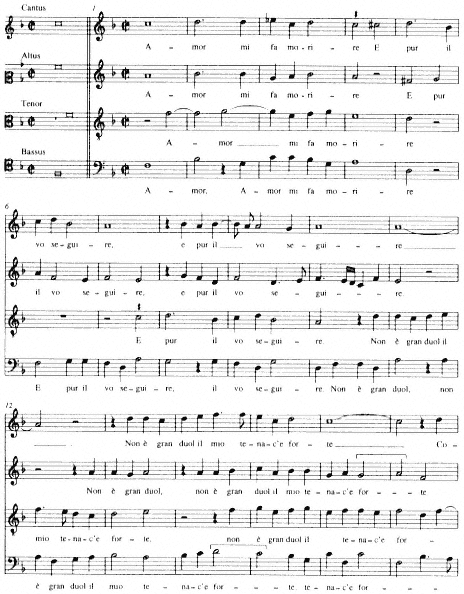
Ex. 9.
Willaert, Amor mi fa morire (Dragonetto Bonifazio), incl.; in Verdelot, Secondo
libro a 4 (Venice, 1536) (RISM 15367 ), no. 1.
(continued on next page)
(continued from previous page)
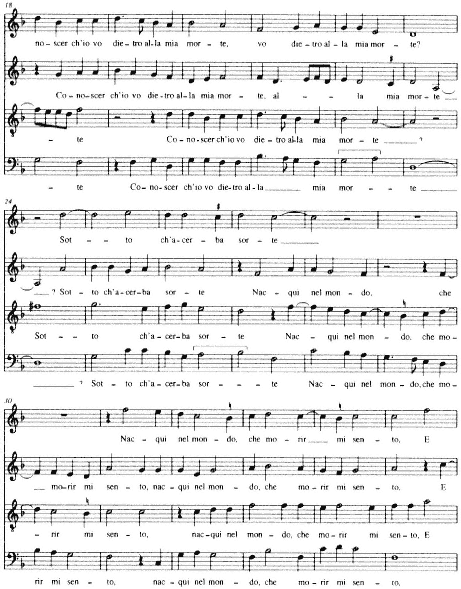
Ex. 9
(continued)
(continued on next page)
(continued from previous page)
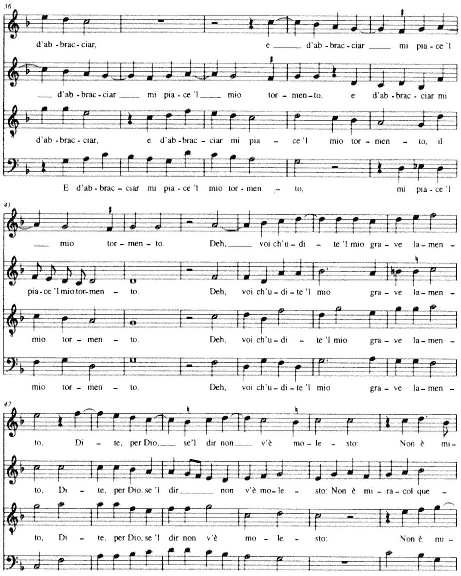
Ex. 9
(continued)
(continuedon next page)
(continued from previous page)
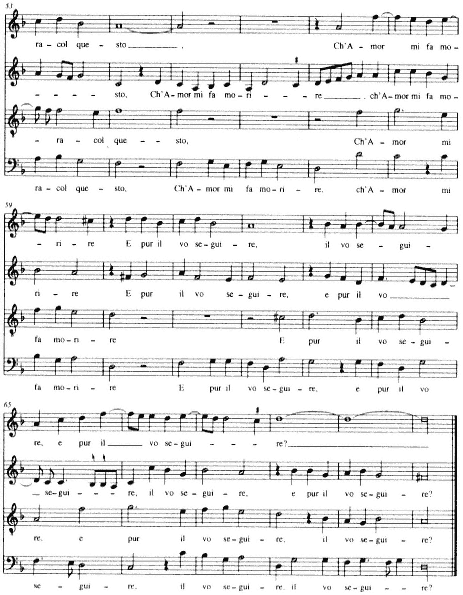
Ex. 9
|
Willaert's setting adheres to the phraseology of French and Italian song styles that binds each poetic line to a single musical phrase. His rendition favors a reading based on versification, so much so that even the enjambment of lines 5 and 6 produces two distinct musical phrases.[20] Yet it still practices a northern art of imitation.
At a higher level the setting divides the twelve poetic lines into structural groups formed around five verbal periods:
|
Each of these poetic divisions in turn finds support in an interwoven system of melodies and cadences (see Table 3), still wholly based in the traditional tenor-
[19] Note that the prime sign (') below indicates varied repeat of a phrase.
[20] Although sixteenth-century madrigals were often performed with instruments taking at least some of the parts or doubling voices, my critical discussions in Chapters 7-10 treat all voices as if they were sung. Since all of the madrigals I discuss in Part 3 were conceived in such a way that all parts would provide viable poetic readings when performed by voices, this seems reasonable analytically but it should not be taken to dismiss or minimize the historical existence of other kinds of performances.
Readers wishing fuller access to the madrigals under discussion should consult modern editions of them, as listed below. My identifications of poets come from Il nuovo Vogel except where otherwise noted. I have added poetic sources wherever possible. I am grateful to Lorenzo Bianconi and Antonio Vassalli for use of their handwritten catalogue of sixteenth-century poetic incipits and to Michael Keller, Anthony Newcomb, and Shuli Roth for use of the computer database of cinquecento poetry at the University of California at Berkeley.
| |||||||||||||||||||||||||||||||||||||||||||||||||||||||||||||||||||||||||||||||||||||||||||||||||||||||||||||||||||||||||||||||||||||||||||||||||
superius framework.[21] The madrigal proceeds from a d-mollis tonality strongly polarized with A. Its first important cadence, between the cantus on aa and tenor on a over D in the bass (m. 10), rounds off the opening two settenari. As the poetic refrain that will close the piece, these lines need to be firmly anchored, and Willaert does so by treating line 1 as an antecedent, brought to a half cadence (m. 4), and line 2 as a consequent. By letting line 2 cadence fleetingly on f/F (altus-bassus, m. 7) and then, more strongly, on the D-major chord (m. 10), Willaert's setting makes the whole into a tiny, but balanced, bar form aimed toward the final. F retains its status as a secondary
[21] The designation of pitches in Table 3 and elsewhere follows Renaissance practice, with each octave conceived as proceeding upward from pitch G and c designating our "middle c."When speaking of pitch class generally, without reference to particular register, I simply use upper-case letters.
cadential degree and D as a primary degree as the quasi-mutazioni first cadence in a decorative suspension to f/F at mm. 17-18 and then in a hollow open-fifth at m. 23. The last resounds with D in no fewer than three voices (cantus, altus, bassus), while the tenor lingers on the a it had sung in the penultimate cadential sonority. It might seem surprising that this otherwise traditional tenor should retire contrapuntally at a moment of such clear structural definition. But doing so enables it to leap dramatically to center stage, its unexpected high f-sharp attack at m. 24 beaconing the tonal reorientation to come with the "bitter fate" of the third period.
F-sharp is an outsider in the D/A tonal world of the ripresa. The diminished-fourth cross relation it forms with the alto's bb-flat — and that bb-flat's augmented-fourth cross relation with the cantus's ee (m. 25) — subverts the tonal calm that had prevailed in the ripresa . Ultimately the tonality is riveted to a new axis of pitches, F and C, which dominate the medial third and fourth poetic periods, approached through a detour past G at line 7(m. 42).[22] The shift amounts to a change of modal orientation from Hypoaeolian to Hypolydian that first emerges in a series of evaded cadences at midverse, with falling fourths, ff to c, in the cantus (mm. 31, 33, etc.). Eventually the cadences take up more clear-cut positions at verse endings (mm. 35, 47, 51), reinforcing the shift of modality. Only after D is summoned back with phrase B2 and the start of the last period, "Non è miracol questo," does the madrigal meld seamlessly into a return of the opening.
In Amor mi fa morire, then, Willaert put northern contrapuntal skills to novel expressive use. Pitch emphases, voice leading, and modal relationships all quietly shape prosodic structures at the two levels of verses and periods. The madrigal's new coloristic expressivity — the cross relation between ee-flat and e at the very opening (m. 3) and cross relations highlighting the "bitter fate" in mm. 24-25 noted earlier — introduces a refined dramatic tension into the handling of the verse structure. Some of the madrigal's rhetorical gestures, like the abrupt pause and textural shift to near-homorhythm at the exclamatory "Deh, voi ch'udite 'l mio grave lamento" in the midst of otherwise staggered declamation, are boldly new. Its imaginative transitions between verses call to mind the formal subtlety often heard in Arcadelt's madrigals of the 1530s, most famously Il bianco e dolce cigno from the Primo libro of 1539. And yet with all this, musical accents are allied to words in melodies free enough to allow a virtually infallible diction.
Despite these novelties, Willaert's Amor mi fa morire is closer to Verdelot's style than to anything Willaert composed in later years. The music remains syllabic with many short phrases, cadences (including many Landini cadences) at the end of nearly every verse, minimal text repetition, frequent four-square metric patterns,
[22] This sort of medial modal contrast parallels that undertaken in contemporary chansons, as Howard Mayer Brown pointed out with respect to Willaert and Verdelot; see "Words and Music: Willaert, the Chanson, and the Madrigal about 1540," in Florence and Venice, Comparisons and Relations: Acts of Two Conferences at Villa I Tatti in 1976-1977, vol. 2, Il cinquecento, ed. Christine Smith with Salvatore I. Camporeale (Florence, 1980), pp. 217-66. Comparable events in chansons are generally managed within a much more controllable verbal space — four or five lines of equal length and rhythmic character.
enlivened chordal textures built mainly around tenor and cantus, and a rounded formal structure. The musical treatment of vv. 1-2 as a single bipartite unit — the latter part essentially a variation of the former with a "half cadence" separating the two (m. 4) — recalls the handling of seven-syllable couplets typical in the repertories of both frottola and early madrigal. These qualities serve as a reminder that Willaert largely preserved the formalistic approach that Howard Mayer Brown identified in likening one of his chansons to a madrigal of Verdelot's.[23] What is more, the novelties I have noted in Amor mi fa morire move it farther from Verdelot's style than any of the other madrigals in the 1534 collection do. A typically Verdelot-styled setting of a ballata-madrigal is Willaert's Madonna, il bel desire, whose melodic repetitions are far more schematic:[24]
|
Like many early-sixteenth-century song settings, Madonna, il bel desire assembles jigsaw fashion four distinct melodic strains. Each of these strains plays a discrete rhythmic-harmonic role: phrase A that of an initiating gesture for settenari; phrase B a more elaborated melody for endecasillabi, tracing a falling-ff-to-final-g curve; phrase C a short open-ended melody for paired settenari, supported frottola-like by
[23] Ibid.
[24] The madrigal has a mixed attribution history. In RISM 153416, 15367, and 153710, it is assigned to Willaert. In 154020, Scotto's combined edition of Verdelot's first and second books for four voices, it appears to be attributed to Verdelot, as Gardane apparently believed in assigning it to Verdelot in 1541 . As Stanley Boorman has argued, however, this is probably only a result of the fact that the madrigal begins in the middle of a recto with Verdelot's name in the header and with a madrigal of Verdelot's immediately preceding Madonna, il bel desire. In 1540 Willaert's name does not appear until the header of the verso on which Madonna is completed. See Boorman, "Some Non-Conflicting Attributions, and Some Newly Anonymous Compositions, from the Early Sixteenth Century," Early Music History 6 (1986): 125-27 and 157.
For scores of Madonna and other madrigals by Willaert not published in the Musica nova see Willaert, Opera omnia, Corpus mensurabilis musicae, no. 3, AIM, vol. 14, ed. Helga Meier (NeuhausenStuttgart, 1977).

Ex. 10.
Willaert, Signora dolce, io te vorrei parlare, cantus, mm. 1-11; in Verdelot,
Secondo libro a 4 (Venice, 1536) (RISM 15367 ), no. 2.
a homorhythmic minim chain with a weak-beat ending; and phrase D a medial endecasillabo melody arching from bb-flat up to dd and down to d below.
There is even more archaism, albeit of an eclectic sort, in other madrigals from 1534. Quando gionse per gli occhi al cor, madonna recalls the old Florentine ballate of Heinrich Isaac, Alessandro Coppini, and Bartolomeo degli Organi: strong metrical rhythms and syncopations, triple-meter shifts, and passages of homorhythm (mm. 31ff.). And the quasi-medieval floating lines and fragile melismas of Signora dolce, io te vorrei parlare, a chivalric offer of secret servitude to a "sweet lady," harken back to the chansons of the fifteenth-century rhétoriqueurs.[25] (See the opening bars of the cantus in Ex. 10.)
By 1540 Willaert's anthologized madrigals, even the ones for four voices, had already grown distant from Verdelot's balanced songlike conception. The difference is striking in Già mi godea felice ogni mio bene,[26] one of Willaert's contributions to Scotto's reprint edition Di Verdelotto tutti li madrigali del primo, et secondo libro a quatro voci (154020 ). This piece sets a little eight-line madrigal, disposed in the near-symmetrical scheme ABbA CddC.
Già mi godea felice ogni mio bene, Once I gladly enjoyed all my good fortune,
Hor, sì longo al mio ben, tal doglio Now, so far from my loved one, I feel such
sento, grief
Che più crudel tormento That I have never had a more cruel torment,
Non hebbi hormai, nè sì gravose pene. Nor such a grave pain as now.
Felic'era'l mio amor, felic'ero io; Happy was my love, happy was I;
Hor, benchè sia'l mio core Now, though my heart is
Sì lontan dal suo amore, So far from its love,
Fie volendo felice l'amor mio. Let my love be happy if it wishes.[27]
The poem is a study in simple symmetries, yet Willaert's setting counteracts nearly all of them: the anaphora, repetitions of rhymes, and evenly deployed paradoxes. Its melodies wind out motet-style in a formidable 99 breves (not much shy of the 120
[25] This funny little text does not even scan as proper seven- and eleven-syllable lyric verse.
[26] Willaert may have gotten the text from Constanzo Festa's setting in the latter's Primo libro of 1538. No poetic source is known.
[27] I am grateful to Elissa Weaver for help in translating several poems in this chapter, including this one.
or so typical of his sonnet settings), with little regard for the length or overall rhythmic character of each verse. The declamatory pacing varies widely, from the opening, dominated by breve and semibreve declamation, to subsequent passages declaimed continuously in minims (Ex. 11). Added to all this are several extended melismas, all of these thwarting any clear perception of the poem's versification.
Nevertheless, Willaert did not ignore the poem's larger verbal structures altogether. On the contrary, he magnified the rhetorical-rhythmic closes, culminating the ends of each half with multiple textual repetitions that stretch line 4 over 23 breves and line 8 over 16 1/2. Other tactics gather momentum toward these final cadences too: the cantus makes a prolonged ascent to gg shortly before the close of the first half and florid, sequenced melismas before the very end. As he did in setting Amor mi fa morire, Willaert brought into relief the internal apex of the poem by carrying line 4 to the madrigal's farthest point of modal remove — in this case an evaded, overlapped cadence on f/D — and then turned almost immediately back to the original tonality of C durus.[28]
Ironically, Willaert spun out these simple verses with more pliant, elongated melodies than he had ever used before, forsaking the prosodic rhythms that had previously been fundamental to Italian lyric song. Già mi godea and other madrigals of 1540 also mark the beginning of Willaert's experimentation with subtle manipulations of timbre, generated by variously blending and reblending different vocal groups. Certainly none of his earlier expositions looks anything like the one in Ex. 11, which weaves a highly individuated cantus and altus into a spare duo for eight long measures before finally repeating v. 1 a quattro. The madrigal's subsequent dispositions of text continue to project varied groupings that intersect and overlap one upon another, as at line 6 (mm. 71-79), where three high voices replace three low ones. The technique is strikingly new in a four-voice texture and profoundly unsettling to the traditional cantus-tenor edifice on which the madrigal's earlier song textures — even less conventional ones like Amor mi fa morire (Ex.9) — had been built.
Scotto's four-voice reprint of Verdelot presented two more of Willaert's madrigals. One set a lengthy madrigal text, Così vincete in terra,[29] a fourteen-line encomium of a woman, in a style much like that of the 1534 collection. But the other introduced Willaert's first published sonnet setting, Qual anima ignorante over più saggia (set in toto, as all his essays in the sonnet were to be). Qual anima ignorante is a Petrarchan lament loosely modeled after Petrarch's In qual parte del ciel (no. 159), complete with repetitive rhetorical constructions and pervasive antitheses. Its only debt to repetitive song forms is an internal refrain, lines 3-4 returning as lines 7-8.
[28] After the close of v. 4 nearly all the cadences land on C (e.g.,m. 75, m.80, m.91), with the exception of mm. 66-67.
[29] An anonymous setting of the same text survives in I-Bc, MS Q21, which dates from ca. 1526; see Fenlon and Haar, The Italian Madrigal, pp. 137-39.
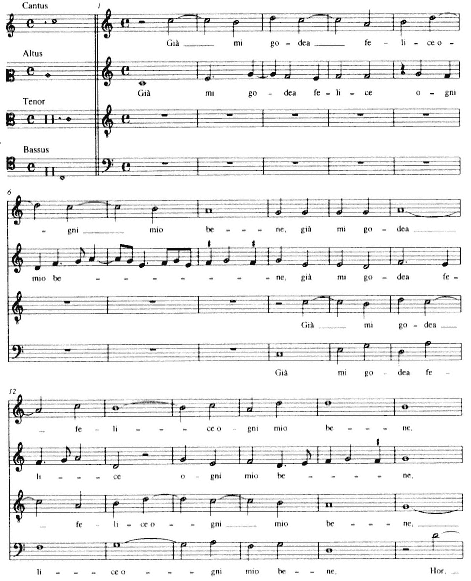
Ex. 11.
Willaert, Già mi godea felice ogni mio bene, mm. 1-17; in Di Verdelotto tutti li
madrigali del primo, et secondo libro a 4 (Venice, 1540) (RISM 154020 ), p. 47.
Qual anima ignorante over più saggia What soul ignorant or more wise,
Qual huom mortal, qual dio, qual donn'o diva, What mortal man, what god, what woman or goddess
Che non sappia 'l mio mal onde deriva, That might not know from whence my woe derives
E del mio grand'ardor pietà non haggia. And might not pity my great ardor? 4
Qual selv'è sì riposta o sì selvaggia What woods so hidden or so savage,
Qual lauro in aria cresce o qual oliva, What laurel rising in the air or what olive tree
Che non sappia 'l mio mal onde deriva, That may not know from whence my woe derives
E del mio grand'ardor pietà non haggia. And may not pity my great ardor? 8
Qual part'hoggi del mondo, che non sia What part of the world today that is not
Delle lagrime pien'e di lamento, Full of tears and of laments,
Delle voci, sospir'e doglia mia. Of voices, sighs, and my griefs? 11
Non giace cosa hormai sotto la via Not a thing now lies beneath the path
Del ciel che non conosca 'l mio tormento, Of heaven that does not know my torment
Se non sola colei, ch'io sol vorria. But her alone whom I alone desire. 14
Willaert's setting of Qual anima ignorante continued the trajectory of other madrigals from 1540, though the basic conception differs from that of sonnet settings in the Musica nova . Willaert made no seconda parte for the sestet or any double-bar division at all and matched the poetic refrain with the same music. In these respects the setting follows conventional norms for setting the lighter forms of the ballata and madrigal. Yet some of the elastic pacing and varied vocal scoring of Già mi godea finds its way into Qual anima ignorante, especially in the last tercet, where the previously languorous rhythms unexpectedly pick up. Here too Willaert loosed the restraints of a prosodic approach by fully recognizing the poetic enjambment with a continuous musical phrase (mm. 110-11).
All three of the poets in 154020 have continued to elude identification. The point is suggestive, for it relates to Willaert's general disengagement in anthologized madrigals from verse authorized by classical tradition or having pretensions to the highest literary pedigree. If the poets' voices remain so consistently unrecoverable in our day, they were probably muted in Willaert's too. More than theirs, it was probably Willaert's voice that resonated "authorially" among buyers and auditors in salons and print shops. This does not mean that poems were typically chosen through Willaert's agency or authority: the mechanisms through which he acquired texts remain mysterious and the impetuses for his settling on one or another were probably as fragmentary and diverse as their printing venues.
Both of Willaert's two five-voice madrigals featured in Scotto's anthology Le dotte, et eccellente compositioni de i madrigali a cinque voci (RISM 154018 ) may have arisen at the behest of particular patrons or for special occasions.[30] One of these is
[30] As Fenlon and Haar point out, the composers listed in this print appear in "what looks like a descending order of importance" (ibid., p. 313): Willaert, "suo discipulo" Leonardo (Leonardus) Barré, Verdelot, Arcadelt, Festa, Corteccia, Berchem, and so on (the order thereafter becomes slightly less straightforward) — an arrangement only a little different from that given on the title page of the cantus part book. The undated print RISM [153820] (Il nuovo Vogel, no. 2883) is undoubtedly a later reprint of 154018, as established by Mary S. Lewis, "Antonio Gardane and His Publications of Sacred Music, 1538-55" (Ph.D. diss., Brandeis University, 1979), p. 629, and Fenlon and Haar, The Italian Madrigal, p. 313.
the famous homage to Polissena Pecorina, Qual dolcezza giamai (the text of which appears in Chap. 2, pp. 34-35). Qual dolcezza giamai is the only madrigal from these years that essays an explicitly celebratory style, with appealing melodies that have little place in Willaert's Petrarch settings. The graceful, catchy soggetto in Ex. 12, announced by the tenor under a shimmery alto countersubject and imitated at m. 5 by the cantus, has no analogues among expositions in the Musica nova. Einstein viewed this kind of five-part writing as technically new; "the choral response, the vocal coloring (one might call it 'vocal glazing'). Just as a painter covers over but does not conceal a shining ground color with another one, delicate and transparent, so Willaert superimposes upon a prominent voice, the bearer of the espressivo, another purely radiant one."[31] Einstein did not link this to the celebratory nature of the text. But he did note the new dramatic potential inherent in such textural flexibility and particularly the rhetorical and timbral possibilities in treating the fivepart madrigal as two four-part textures (as happens at the beginning of the seconda parte ). (The only text for which Verdelot uses such a technique in the same print is an actual dialogue.) In making the words easily perceptible, Willaert also kept the declamatory meter uniform, even when the parts give out different rhythms and melodies on the same words. His short, simple formulas for acclamations like "Desta nei cor" usually repeat the same motive (as shown in Ex. 13) but also vary it with the more athletic motion of the bassus (Ex. 13b) or the rising movement of the altus (Ex. 13c). Willaert pitched settings like these to a lighter — hence lower — stylistic level than his settings for the Musica nova (even switching to a near-homorhythmic triple time at "Et si rallegra in ciel di gir'in giro").
Though Qual dolcezza giamai progresses through an accumulation of enjambments (vv. 1-3, 5-6, 7-8, 10-11, 13-14), Willaert's setting still largely ties its phrases and contrapuntal articulations to the poem's versification.[32] Superficially the parts appear to function autonomously, but Willaert stitches them to a series of cadences that coordinate the parts at moments of prosodic definition (note the four upper voices at m. 13, Ex. 12).[33] The combination of relatively short melodious strains and frequent multivoice cadencing keeps the words clear and the texture delightfully transparent.
Both Qual dolcezza giamai and the other setting in Le dotte, the ballata Quanto più m'arde e più s'accende il foco, may owe their existence to local sources of patronage.
[31] The Italian Madrigal 1:327-28.
[32] The only exception is that of the strong enjambment that opens the second part, "A la dolce armonia si fa serena / L'aria, s'acqueta il mar, taccion'i venti" (At the sweet harmony the air becomes / serene, the sea calms, the wind turns quiet), for which Willaert provided a separate exposition for "A la dolce armonia," and then made what follows continuous.
[33] Some of these cadences involve as many as all five voices, for example, mm. 79, 84, and the general pause preceding the triple-time passage, m. 63. For the full setting see Willaert, Opera omnia 14:65-70.
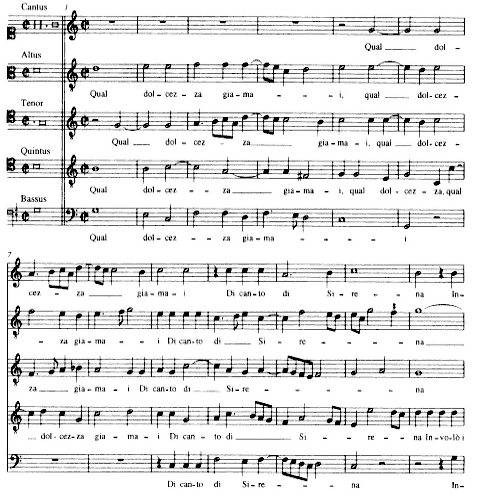
Ex. 12.
Willaert, Qual dolcezza giamai, mm. 1-13; in Le dotte, et eccellente compositioni de
i madrigali a 5 (Venice, 1540) (RISM 154018 ), p. 1.
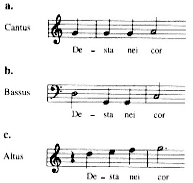
Ex. 13.
Willaert, Qual dolcezza giamai: a,
m. 33; b, mm. 32-33; and c, mm. 36-37;
in Le dotte, et eccellente compositioni
de i madrigali a 5 (Venice, 1540)
(RISM 154018 ), p. 1.
Quanto più m'arde had recently been published (like Già mi godea ) in a setting by Constanzo Festa,[34] and in light of Festa's previous settings of both texts one cannot discount the possibility of a Strozzi connection. Both Quanto più m'arde and Già mi godea remain without poetic identifications. But an important poet-patron of Festa's (and one not represented in surviving literary sources) had significant Venetian connections, namely Filippo Strozzi. One of Willaert's anthologized madrigals, the six-voice Rompi dell'empio core il duro scoglio, published the year after Le dotte in Verdelot's six-voice print La più divina musica (154116 ), set Strozzi's invective on his incarceration by the Medici. By 1541 Filippo had been dead for about three years (as noted in Chapter 2), but his trusted nephew Neri Capponi and sons Piero and Ruberto maintained a Strozzi presence in Venice. Since Festa benefited from Filippo's patronage and set his poems to music,[35] it is tempting to consider whether Willaert may have reset texts set by Festa because they were Strozzi's.
Such a scenario seems plausible in view of Willaert's having composed music for both texts. And Quanto più m'arde shares with an attributed Strozzi poem set by Willaert about 1542, Rompi dell'empio cor il duro scoglio, a darker, more dramatic expression than found in any of Willaert's previous settings. Einstein singled out Willaert's Quanto più m'arde for the violent rhetoric it used to assail the poem's mass of Petrarchan oppositions: death is sweet, pain a jest; ice does not freeze, or fire burn, grief grieve, or death kill; thus does the poet beg Love to freeze, inflame, and kill him.[36]
In lieu of such additive development, Rompi dell'empio cor weaves a bitter address to a "cruel lady" into the theme of Filippo's imprisonment.
Rompi dell'empio cor il duro scoglio Break the hard reef of your evil heart,
Depon gli sdegn'e l'ire Put down your ire and your disdain,
Hormai, donna crudel, depon l'orgoglio, Now, cruel lady, swallow your pride;
Nè ti rincresc'udire, Don't be unhappy to hear
Com'io, giont'al morire, How I, having arrived at death, 5
Non più di te d'amor del ciel mi doglio. No longer grieve for you, for love of Heaven;
Ma sol qual cign'in trist'accenti chieggio, But only like a swan in sad tones ask
Che se m'odiast'in vita That if you hated me in life,
Non mi niegh'un sospir alla partita. You not deny me a sigh at my departure.
Ah, dove folle son, come Ah, where am I going mad, why do
vaneggio? I rave on? 10
Qui non m'od'o risponde Here no one hears or answers me
Altri che de Mugnon le riv'e l'onde. But the shores and waves of Mugnone.
[34] Festa's setting was printed in Arcadelt's Terzo libro a 4 (Venice, 1539). There is also a setting of the poem in Scotto's Primo libro a 4 of 1542.
[35] See Richard J. Agee, "Filippo Strozzi and the Early Madrigal," JAMS 38 (1985): 227-37.
[36] The Italian Madrigal 1:329, where the text is not mentioned by incipit.
Given the continued presence in Venice of the Strozzi sons, especially Ruberto, Willaert's setting may have served as a eulogy, with its deep tessituras and large scoring (it is his only anthologized setting for six voices).[37]
In 1542 Willaert published his second sonnet setting, Chi volesse saper che cos'è amore, again in one complete part. The setting was included in Scotto's Madrigali a quatro voce con alcuni alla misura breve as one of the black-note madrigals, though it bore the unusual time signature O (tempus perfectum, prolatio imperfecta ). In the same year Willaert also published what are now his first firmly datable settings of Petrarch, Qual più diversa e nova cosa and Quante volte diss'io (Canzoniere, nos. 135 and 126). Remarkably, canzone stanzas are Willaert's only known Petrarch settings outside of the Musica nova.
Then in 1544 came the three settings in Di Cipriano il secondo libro de madregali a cinque voci insieme alcuni di M. Adriano et altri autori a misura comune novamente posti in luce a cinque voci (RISM 154417 ), nominally Rore's second book albeit with only eight of his madrigals. Willaert's settings assume an almost equal symbolic position in the collection next to Rore's,[38] with both composers arranged as symmetrical frames for the rest: the print begins with a madrigal each by Rore and then Willaert and ends with the reverse — perhaps a bow to age. Otherwise it resembles other books issued by Venetian printers in the 1540s that presented works by local Willaertians like Perissone, Jachet Berchem, Leonardus Barré, and Parabosco.[39] More will be said about the print in Chapters 8 and 9. For the moment it is important to note how many rhetorically conceived settings clustered in it all at once, signaling the gradual displacement of Florentine madrigalian style in the face of a growing consolidation and diffusion of Venetian practices.
Notwithstanding this, Willaert's anthologized madrigals continued setting texts outside the literary canon of Petrarch, Bembo, Sannazaro, and Ariosto. All the verse in
[37] Possibly Willaert resorted to mode 3 for the same reason. His use of Hypophrygian for one of the only two sonnets from the "in morte" portion of Petrarch's Canzoniere included in the Musica nova (Mentre che'l cor dagli amorosi vermi ) makes me think he may have.
For identification of Rompi dell'empio core and its sources see Eugenia Levi, ed., Lirica italiana nel cinquecento e nel seicento fino all'Arcadia . . . (Florence, 1909), pp. 307, 419, and 445.
[38] It should be noted that Einstein doubted the authenticity of the second, a resetting of Qual anima ignorante, on the grounds of its voice leading and what he took to be removal of the attribution to Willaert in later editions of Rore's Secondo libro (The Italian Madrigal 1:329). To be sure it is difficult to explain the presence of a passage with parallel fifths between tenor and bassus, like that from the upbeat of m. 53 to m.55. Yet the madrigal is also attributed to Willaert in various reprint editions (see Il nuovo Vogel 2:1487-88).
[39] See Table 8. Similar prints include the 1546 reprint of Verdelot's six-voice volume La piu divina, et piu bella musica, originally issued by Gardane in 1541 and later reprinted by him as Madrigali di Verdelot et de altri autori a sei voci novamente con alcuni madrigali novi ristampati & corretti a sei voci (RISM 154619) with madrigals by Noletto (Nolet or Noleth, known from Doni's Dialogo della musica), Jachet Berchem, Parabosco, and Perissone, among others; and Rore's third book, Di Cipriano Rore et di altri eccellentissimi musici il terzo libro di madrigali a cinque voci, as published by Scotto in 1548 (15489) with madrigals by Rore, Perissone, Donato, Willaert, Gabriele Martinengo, and Zarlino. Venetian composers are also scattered throughout Scotto's Verdelot reprint Le dotte, et eccellente compositioni de i madrigali a cinque voci da diversi perfettissimi musici fatte. Novamente raccolte, & con ogni diligentia stampate (RISM 154018), reprinted in 1541 and 1549, which includes works of Verdelot, Willaert, Barré, Constanzo Festa, Arcadelt, Corteccia, Berchem, Yvo, and Nolet.
the 1544 group remains anonymous and some of it ventures strategies of voice and address foreign to conventional lyrics of the early cinquecento. The unorthodox Sciocco fu 'l tuo desire — a lengthy ballata-madrigal couched in the invective of a woman called "Chiara" who rails against the folly and ills of a noble lover — turns on its head the notion that Venetian polyphonists adhered to strictly Bembist literary norms.
Sciocco fu 'l tuo desire Foolish was your desire
Veramente pensando ch'a miei danni In truly imagining that at my expense
Teco n'entrassi a gli amorosi affanni. I should enter into amorous troubles with you.
Mi maraviglio, quando I wonder that
Non anchor chiaro sei del foll'errore, You are not yet certain of the foolish error, 5
E come desiando And how you lost days and hours
L'amor mio ne perdest'i giorni e l'hore. In craving my love.
Donna cortes'e humana A courteous, humane woman
Con vil amante certo mal s'accorda. With a vile lover surely is badly matched.
Non mi conosci, o cieca mente insana You do not know me, o blind twisted mind 10
Di bastardo, nè vo' che per me leggi Of a bastard, nor do I want you to read me
El suon di privileggi The sound of your
Tuoi ch'ogni orecchia assorda. Titles, which deafen every ear.
Hor tienti al mio consiglio: Now take my advice:
Pon giù, se puoi, l'insania e cangia Set aside, if you can, your madness and change
l'ire, your wrath, 15
Ch'assembr'al vespertil e non al giglio. Which resembles bats, not lilies.
Chiara son io, qual fui, nè mi scompiglio I am Chiara, as I was, nor do I
A fart'il vero udire: Trouble myself to make you hear the truth:
Se di te mai pensai, poss'io morire. If I ever thought about you, I might die.
The poem's harsh, chiseled diction replaces Petrarch's lyric meditations with the direct discourse not just of a real-life lover but a female one, no less, and frames her speech in vituperative secular protestations linked with class. Chiara's low-styled cannonade on her lover's high-born vice foregrounds the matter of social rank as it inverts it. She delivers her tirade in a familiarizing second-person singular, crescen-doing from passato remoto to present tense (v. 8) and finally to a rebuke aimed, at last, not (Petrarchistically) at herself but at him. Even the familiar turn to dying for the final rhetorical point does not propose a Petrarchan love-death — a love that ambivalently relishes love pangs as welcome death — but rather hints formally at Petrarch's paradox to reject it. The poem resembles Veronica Franco's invective retorts to challenges to her class and virtue from later in the century (cf. Chap. I, n. 35). Yet madrigalian settings of texts spoken either in a woman's voice or even in a voice overtly aligned with class were rare throughout the sixteenth century, making this one striking despite the relatively neutral treatment Willaert gave it. Rather than embodying the text's invective realism in musical events, Willaert realized it by continuing to experiment with different three- and four-voice choral responses, especially at the most heated and direct parts of Chiara's tirade — the declamation of
v. 12, "El suon di privileggi," whipping by in minims and fast registral shifts of dialogue, or again for the imperative of v. 14, "Hor tienti al mio consiglio."
It is instructive to recall that the madrigals in Rore's Secondo libro were published in the same year Doni described Neri Capponi hoarding Willaert's music, music undoubtedly kept from print for a long time afterward (see Chap. 2 above, nn. 38-39). This coincidence underscores the impression that social polarities were crucial in segregating public madrigals from private ones, and that the madrigals of the Secondo libro were textual and stylistic exemplars of the former ilk, while those kept by Capponi were marked by Musica nova -like reserve. More than that, the stylistic, thematic, bibliographical, and biographical evidence clustering on each side of this polarity suggests that social contexts actually worked to exaggerate differences between them.
From this point on Willaert essentially reworked approaches he had developed by the early to mid-forties. The five madrigals published in Rore's Third Book set occasional texts, with only one or two exceptions, but did not experiment with new approaches.[40] Nothing in subsequent publications surprises much either, except perhaps a spiritual madrigal published posthumously in 1563 — a modified terza rima that turns out to be a gloss of Jacopo Sannazaro's capitolo Se mai per meraviglia alzando il viso (note the adaptation of Sannazaro's second, third, sixth, and part of the fourth stanzas indicated below).
Poem Set by Willaert (with rhyme scheme) Stanze from Sannazaro's Poem
a Piangete' egri mortali, 3 Piangete il grave universal dolore
B Piangete l'aspra morte del Signore, Piangete l'aspra morte e 'l crudo affanno
B Se spirto di pietà vi punge il core. Se spirto di pietà vi punge il core.
C Volgete gli occhi in qua c'hoggi dimostra 2 Volgete gli occhi in qua, che ve presente
D Non quella forma, oimè, non quel colore Non quella forma (ahimè), non quel dolore
C Che finge forse i sensi in mente vostra. Che contemplaron gli occhi de la mente.
e Vedete 'l volto esangue 6 Ecco che hor vi dimostra il volto exangue
F Le chiome lacerate, il capo basso, Le chiome lacerate: el capo basso
E Qual rosa che calcata in terra langue. Come rosa dismessa in terra langue.
G O mirabil pietà, o dolce pegno,
e O sacrosanto sangue,
G Si largamente sparso al duro legno; 4/v.2 Pende come vedete al duro legno.
[40] See Table 2. Amor, da che tu vuoi exemplifies texts that are not specifically occasional, but use the playfully direct voice prevalent in anthologized madrigals: "Amor, da che tu vuoi pur ch'io m'arischi / In udir e vedere / Sirene e Basilischi? / Fammi gratia, signore, / S'egli avvien che mi strugga lo splendore / Di due occhi sireni, e ch'io sia preda / D'un ragionar accorto, / Che chi n'ha colpa creda / Che per udir e per veder sia morto. / Gentil coppia eccellente, / Chi vi mira et ascolta / Solamente una volta / E non mor di piacere, / Può gir arditamente / Ad udir e vedere / Le Sirene d'amor e i Basilischi" (Why do you still want me to endanger myself / By hearing and seeing / Sirens and basilisks? / Do me a favor, Lord, / If it happens that the splendor / Of two serene eyes melts me, and that I am prey / To a crafty reasoning; / For one who is guilty of this believes / That by hearing and seeing he may die. / Gentle excellent couple, / He who gazes at you and listens / Just once / And doesn't die of pleasure / Can turn ardently to listen and see / The sirens of love and the basilisks).
h O rara, o nuova legge,
J Humiliarsi a morte acerba e dura
H Quel che 'l ciel e la terra e 'l mar corregge.
J Piangi mond'orbo, piangi egra natura:
H Morto è 'l pastor per liberar lo gregge,
J Come agnel mansueto alla tonsura.
The similarities between Willaert's and Sannazaro's texts, and especially the publication in 1511 by Franciscus Bossinensis of Sannazaro's text in an anonymous frot-tola setting, presents a potentially fascinating link between Willaert's written polyphony and the capitolo in terza rima so closely identified with oral tradition. Recall that the anonymous setting in Bossinensis's lute book gave every indication of having its genesis in improvised song, indeed song of an epic recitational sort (see Chap. 4 nn. 72-73). As Willaert's only effort at setting terza rima, we might expect to find some semblance of oral genesis in Piangete' egri mortali, but Willaert's madrigal lacks all the traces of oral prehistory that mark the Bossinensis arrangement. The vestigial affinities with oral traditions found in written Italian polyphony from the 1520S and 1530s, even in Willaert's own madrigals of 1534 and his lute intabulations of Verdelot's madrigals from 1536, found no place here.
The collective diversity evinced by the madrigals that Willaert anthologized from the 1530s to 1550s resembles the physiognomy of vernacular literary production during the same period. The earlier end of this span coincides with the beginnings of a phenomenon that parallels our modern-day "journalism," a period when professional polygraphs like Lodovico Domenichi, Lodovico Dolce, Ortensio Landi, Antonfrancesco Doni, and Niccolò Franco began to adapt a wide variety of subjects for popular consumption, often framing them in what I earlier called "dialogic" modes. In 1537 Aretino's Primo libro delle lettere inaugurated the familiar vernacular letter; in 1539 the first anti-Petrarchan parody, Niccolò Franco's Il Petrarchista, dialogo . . . nel quale si scuoprono nuovi secreti sopra il Petrarca, appeared; in 1543 Landi's satirical popularization of the classical genre of paradox Paradossi cioè, sententie fuori del comun parare; and (not least) in 1544 Doni's quasi-comic dialogue evoking the meetings of a musical academy, Dialogo della musica. The playful poetics found in many of Willaert's anthologized texts, the occasional, even biographical side of others, and the appealing musical persona of the settings share the public consciousness of those eclectic literary publications. Both kinds of literary and musical production were designed for the largest possible audience, an audience that thrived on the direct speech and referentiality of realistically situated verse and on the diminutive forms, ludic inversions, and general accessibility to be had in simple plays on Petrarchan courtly love.
Musica Nova and Private Style
Many of the poems set in Willaert's anthologized corpus must have been written by professional polygraphs styling themselves after the prototypes of Franco and Doni, or else by courtier-academists like Spira, Muzio, or Dolce. These new eclectics abounded in the commercializing culture of sixteenth-century Venice, transforming Petrarchan tropes and reworking Petrarch's lyric meditations into the speeches of real-life lovers. The amorous pleas of Quanto più m'arde and pointed diatribes of Rompi dell'empio cor or Sciocco fu 'l tuo desire exemplify the immediacy such verse offered over standard Petrarchan lyrics, even over the shorter canzone stanzas by Petrarch that Willaert anthologized. Still, those canzoni stanzas, alleviated by an admixture of settenari and structurally similar to cinquecento poetic madrigals, offered some relief from the weightiness of Petrarch's ponderous sonnets. Of the anthologized madrigals only seven are sonnet settings and of these Willaert only divided two into two parts. None of the sonnets' authors is known; indeed, only three poets apart from Petrarch can as yet be named for any of Willaert's anthologized settings.
Standing wholly apart from these is the remarkable collection that apparently went so little seen for nearly two decades until it was finally printed with the title Musica nova. Nothing distinguishes the two repertories more than the absence of even a single sonnet by Petrarch among the miscellanea as compared with twenty-four settings of Petrarch's sonnets in the Musica nova, all of which Willaert divided into two parts after the manner of the contemporary motet.
The Musica nova owed its unique complexion to a symbiosis of musical and literary interests that transcends our usual notions of conscientious text setting. Inspired by the wave of Ciceronianism in current literary theory, the madrigals in the collection presented themselves as self-conscious exemplars of a high, serious style. They formed an explicitly secular counterpart to Musica nova's motets (which they followed physically in the print) by their division into two parts, their austerity, the inclusion of four-, five-, six-, and seven-voice settings (like the motets), and the searching nature of their poems. The juxtaposition of Petrarch's sonnets with many motet texts drawn from the Old Testament and dealing with issues of sin and penitence further reinforced the madrigals' parity with the motets.[41]
If the tonal makeup of the four- and seven-voice pieces is any indication, Willaert may have had a direct hand in the structural paralleling of sacred and secular, for motets and madrigals share a partial identity and order that can be seen by comparing Tables 4a and 4b. These tables list what Harold S. Powers has called the "tonal types" employed for the works in each genre, including signatures (or "systems"), cleffings, and finals.[42] Those of the four-voice motets are identical to the four-voice madrigals, with only a minor exception in the inner-voice cleffings of the fourth
[41] See Willaert, Opera omnia 5:iv.
[42] See "Tonal Types and Modal Categories in Renaissance Polyphony," JAMS 34 (1981): 428-70.
| ||||||||||||||||||||||||||||||||||||||||||||||||||||||||||||||||||||||||||||||||||||||||||||||||||||||||||||||||||||||||||||||||||||||||||||||||||||||
pair, while the seven-voice works (including the last four of the five seven-voice motets) are identical except for the signatures in the penultimate pair. Notwithstanding these differences, it is hard to see how such a sequentially ordered pattern of triadic correlations (i.e., system-cleffing-final) could have arisen by coincidence.[43] They raise at least two possibilities: first, that the correspondences between what are mostly unusual tonal types occurred because the paired madrigals
| ||||||||||||||||||||||||||||||||||||||||||||||||||||||||||||||||||||||||||||||||||||||||||||||||||||||||||||||||||||||||||||||||||||||||||||
and motets were to be performed by identical forces in a single venue when they first came into being; and second, that Willaert may even have originally considered planning the madrigal and motet sections as tonal-timbral mirrors of one another. Even though evidence to establish the second of these is lacking, it is useful to recognize that by extending other parallelisms in the collection, such an arrangement would have substantially strengthened the collection's implicit Bembist assertion
that the two categories, sacred and secular, Latin and vernacular, could stand on an equal footing.
Willaert heightened the madrigalistic genre not primarily in these four- and seven-voice works, however; the four-voice works represent the least complex essays in the new style, and the seven-voice works are dialogues that typically pit three- and four-voice groups against one another in large-scale, often homophonic alternations. Instead, the collection is dominated by the madrigals for five and six voices, which incarnated the style at its most sober and introspective and posed the most challenging alternative to preexisting madrigalian norms. Verdelot's five- and six-voice predecessors had shown no signs of pushing the genre toward such a thoroughly polyphonic state. If anything, Willaert's resembled more the continuous, thick polyphony of Gombert's motets, the banderole of post-Josquin international polyphony.
Yet Willaert's idiom differed from both Verdelot's and Gombert's in taking its cue to a far greater extent than either of them did from the words. His settings consistently articulated syntactic structures with musical structure and rhetorical nuances with musical gestures and textures. In accomplishing this in the general "dialect" of the motet, Willaert's Musica nova madrigals participated in the larger project of elevating the vernacular. Now the singing of Italian lyrics could claim a universal significance parallel to the motet's.
This goes far toward explaining what made the sonnet Willaert's ideal vehicle. Sonnets carried rhetorical weight without overwhelming size and naturally invited bipartite division. As a formal genre and one of the most fixed of lyric forms, the sonnet had served as the traditional lyric vehicle for expressing archetypal states of emotion.[44] Literary theorists like Bembo, Ruscelli, and Tasso repeatedly noted that an inevitable corollary of the sonnet's distantly spaced rhymes and long lines (its suono and numero ) was an intrinsic gravità. Within such obdurate matrices as these, poets could impose temporal order on a wide-ranging conceptual space.
Venetian composers found numerous possibilities for musical interpretation of the many temporal-formal schemes that sonnets offered. In the following pages I explore this idea in connection with Petrarch's Pien d'un vago pensier che me desvia. Among sonnets set by Willaert, Pien d'un vago pensier typifies one of the genre's essential strategies, that of locating a spiritual journey within fixed boundaries and demarcating its progress at a series of structurally articulated stages.[45]
[44] See Christoph Kleinhenz, "The Art of the Sonnet," in Francis Petrarch, Six Centuries Later: A Symposium, ed. Aldo Scaglione, North Carolina Studies in the Romance Languages and Literature, Symposia, no. 3 (Chapel Hill and Chicago, 1975), esp. p. 190.
[45] For discussions related to this kind of temporal structuring see Fredi Chiappelli, "An Analysis of Structuration in Petrarch's Poetry," in Francis Petrarch, Six Centuries Later, ed. Scaglione, pp. 105-16; and (more specifically on temporal order in the sonnet) Kleinhenz, "The Art of the Sonnet," ibid., pp. 177-91.
The lyric development I describe is completely undone in Bernardino Tomitano's inversion and rewriting of the sonnet's parts-vv. 1-8 as 8-1 and 9-14 as 14-9 — in a poem included in Rime de' piu illustri poeti italiani scelte dall'abbate Antonini. Parte prima, ed. Annibale Antonini (Paris, 1731), fol. O v', no. 166.
Pien d'un vago pensier che me desvia Full of a yearning thought that makes me stray away
Da tutti gli altri, e fammi al mondo ir solo, From all others and go alone in the world,
Ad hor ad hor a me stesso m'involo, From time to time I steal myself away from myself,
Pur lei cercando che fuggir devria; Still seeking her whom I should flee; 4
E veggiola passar sì dolce e ria And I see her pass so sweet and cruel
Che l'alma trema per levarsi a volo, That my soul trembles to rise in flight,
Tal d'armati sospir conduce stuolo Such a crowd of armed sighs she leads,
Questa bella d'Amor nemica e mia. This lovely enemy of Love and me. 8
Ben, s'io non erro, di pietate un raggio Surely, if I err not, I do discern a ray
Scorgo fra 'l nubiloso altero ciglio, Of pity on her cloudy, proud brow,
Che 'n parte rasserena il cor doglioso: Which partly clears my grieving heart: 11
Allhor raccolgo l'alma, e poi ch'i aggio Then I collect my soul and when I have
Di scovrirle il mio mal preso consiglio, Decided to discover to her my ill-taken counsel,
Tanto le hò a dir che 'ncominciar non oso. I have so much to say to her that I dare not start.[46] 14
Petrarch begins with fantasy, his most fluid medium of movement. The kinetic force that governs this movement is the "vago pensier," the elusive thought that never finds satisfaction in its own self-expression. Steadily the poet moves through a series of unbounded spatial zones. Pulled in turn from the world, from himself, and toward Laura, his soul threatens to take flight, only to be regained unfulfilled. In the end he circles back to his starting point — love unexpressed. Lack of fulfillment and the continual, billowing movement it generates are thus the beginning and end of the poem and the driving impulse throughout.
Successively Petrarch aligns this series of plastic states with the sonnet's compositional structure, matching the migrations of the poet's soul with its four main sections. The first couplet removes him from the world at large to a state of solitude, while the next one rounds off the quatrain with the poet's flight from himself and quest for the beloved. The second quatrain flirts with a potential but frustrated flight of the spirit — a fantasy within the fantasy as he imagines his beloved. In the first tercet the poet hesitantly takes heart from the lady's pity, her half-lucid brow half-clearing his heavy heart. Encouraged, he braces himself to regain his soul ("raccolgo l'alma") in the last tercet — though, predictably, to no avail. These migrations are strung together with enough semantic instability and syntactic fluidity to yield a nearly continual sense of motion. Petrarch's real theme is a spiritual ebbing and flowing, a swaying of the mind. Such psychic movement is the underlying theme of the Canzoniere, a series of internal fluxes that never fully comes to rest and continually refers back to itself. Since the motion is constant, however, it is also static, forever circling with no intended destination but its own self-created world.
[46] Here and below I have taken the liberty of adapting and arranging in verse lines Robert M. Durling's translations of Petrarch's sonnets, Petrarch's Lyric Poems: The "Rime sparse" and Other Lyrics (Cambridge, Mass., 1976). His translations have been invaluable to my work.
Willaert's sacred idiom, with its long-breathed lines constantly overlapping in subtly varied guises and its continual changes of textures and timbres, must have found close company in Petrarch's poetics. Through a continuous, unstable polyphonic web, it realized the meandering syntax Petrarch often utilized to embody his themes of spiritual uncertainty, evoking in musical abstractions effects parallel to Petrarch's verbal ones. (For the complete score see Ex. 14.) Indeed, Willaert set Pien d'un vago pensier without a single notable cadential break except for the one that divides the two parts. The few cadences that occur are so thickly buried in artful counterpoint that they pose little threat to the madrigal's general continuity. Tension is created through constant gesturing toward resolution and turning away, gesturing that recalls Zarlino's descriptions of evaded and extravagant cadences.
Willaert created this kind of polyphony by manipulating the blandest of melodic materials. His melodies largely move in conjunct paths and most of the motives are so mildly profiled as to be almost indistinct from one another. The imitations are generally loose because motivic variation frees up each voice for an independent recitation of the words. Frequently Willaert's melodies move along in chains of minims or alternate unremarkably between minims and semibreves. His soggetti tend to reinforce such regularities, falling out in binary repeated-note groups (as in the opening measures). With few exceptions, the composite declamatory unit holds resolutely to the minim. Most important, this relentlessly even declamation is predicated on a syllabic delivery of the words, with melismas placed few and far between.
Like plainchant, Willaert's declamation and parsing of verse make it seem almost like spoken text, with a resulting emphasis on asymmetrical linear and grammatical constructions. (Notice the localized syntactic articulation given the text at the beginning of the seconda parte. ) Through these various musical techniques, Pien d'un vago pensier (like other madrigals in the Musica nova ) emerges as a subdued musical counterpart of the decorum advocated by Venetian literati and statesmen.
At the same time, the madrigal develops its own musical version of the Bembists' corollary of variazione through its use of constantly shifting materials and forms. The principle of variazione manifests itself most clearly in the changing motivic shapes and accents assigned to different segments of the text. Willaert's preoccupation with diction meant that all the different versions declaimed (soggetti and their variations) had to contain equally accurate patterns of accentuation but not the same rhythmic profile, and the actual pitch content of different statements often seems almost immaterial. Thus, although the same syllables may be stressed in each statement of a textual fragment, the means of accentuation generally differ. Measures 93-103, for example, encompass disparate, overlapping versions of v. II in altus, cantus, and quintus. Willaert renders the third syllable of "rasserena" — the sixth of the endecasillabo and the line's chief poetic accent — in three different ways, each equally suited to the poem's prosody: the altus places -re - on the tactus in a lengthy dotted semibreve (m. 95); the cantus syncopates it on a semibreve (m. 96);
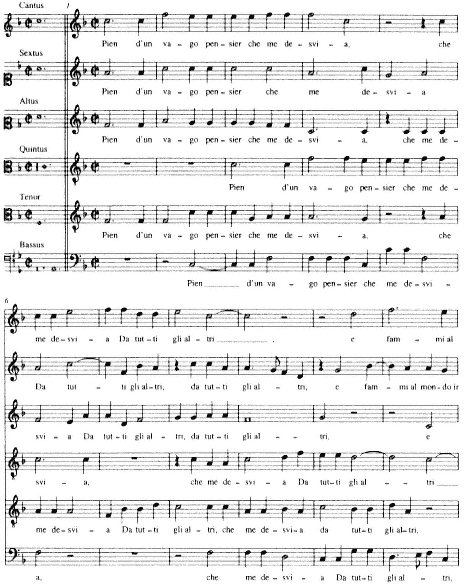
Ex. 14.
Willaert, Pien d'un vago pensier che me desvia (Petrarch, no. 169), incl.;
Musica nova (Venice, 1559), no. 21.
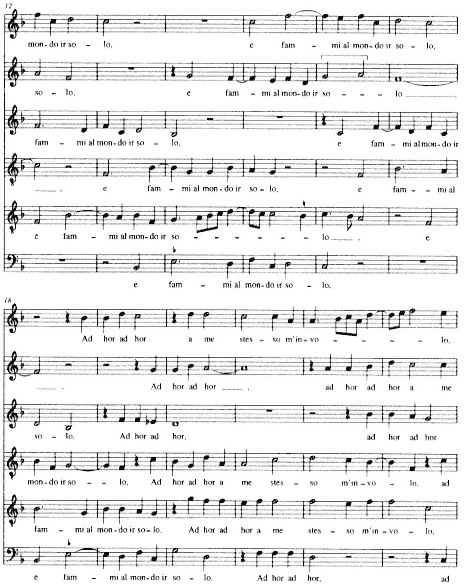
Ex. 14
(continued)
(continued on next page)
(continued from previous page)
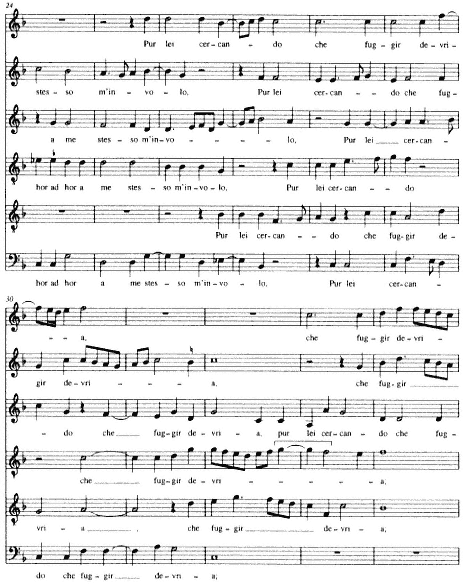
Ex. 14
(continued)
(continued on next page)
(continued from previous page)
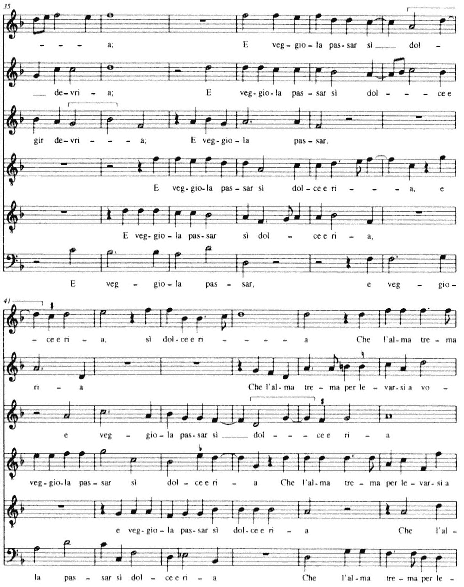
Ex. 14
(continued)
(continued on next page)
(continued from previous page)
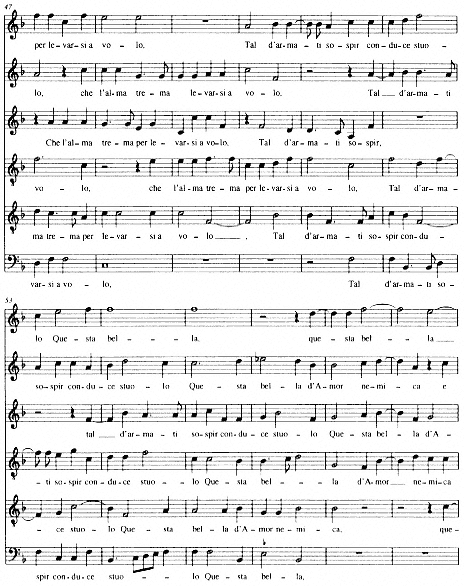
Ex. 14
(continued)
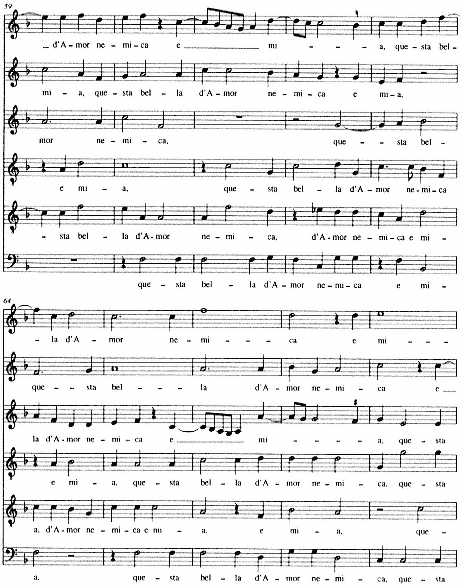
Ex. 14
(continued)
(continued)
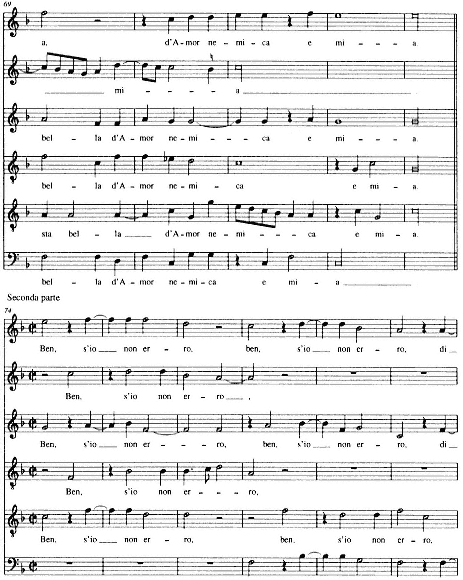
Ex. 14
(continued)
(continued)
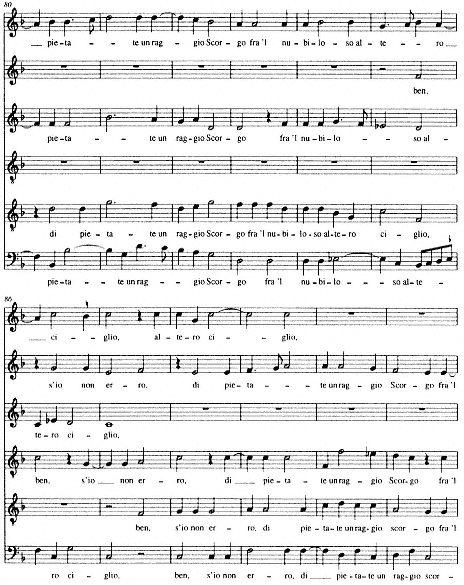
Ex. 14
(continued)
(continued)
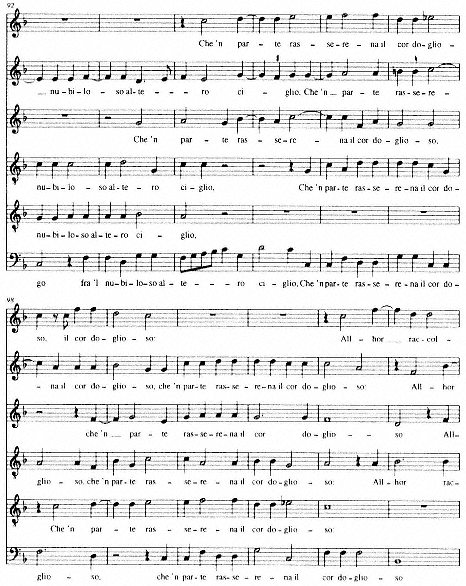
Ex. 14
(continued)
(continued)
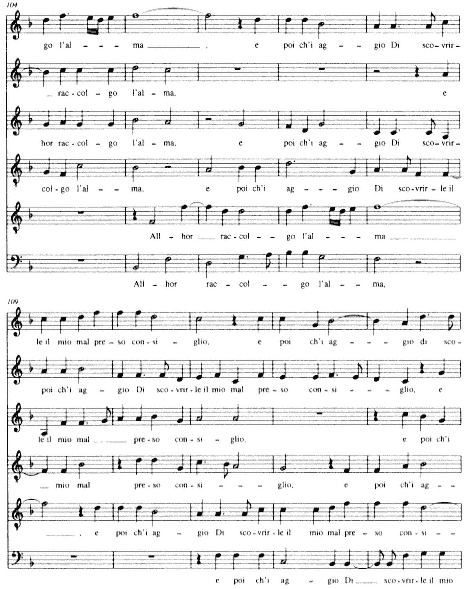
Ex. 14
(continued)
(continued)
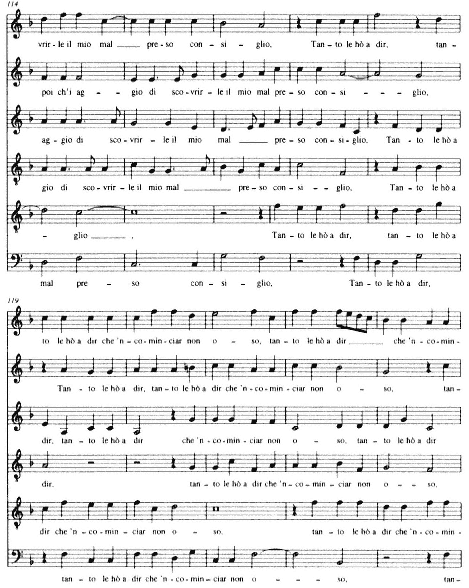
Ex. 14
(continued)
(continued)
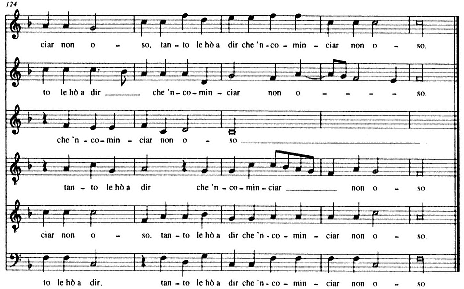
Ex. 14
and the quintus returns it to the tactus with a ubiquitous double-minim figure (m. 97). Both altus and cantus apply agogic accent — prolongation — while the quintus relies wholly on the always unambiguous tonic accent. (A comparable kind of variety obtains with the secondary accent, par - of "parte" near the beginning of the line.) The combined effect of this technique is a lack of any unified polyphonic assertion of meter. In its place a constantly shifting metric polyphony coalesces — faint in its overall level of stress, but pulsating with gentle, inexorable uniformity in the background.
Only on rare occasions, when striking sounds or rhythms appear in the verse, did Willaert project text with a single rhythmic gesture. By contrast with the foregoing, for instance, witness in Ex. 15 the relatively consistent way he set "e rompr'ogn'aspro scoglio" (v. 6 from the five-voice Giunto m'ha Amor fra belle e crude braccia ), with its coarse mouthfuls of r 's, double and triple consonantal clusters, and sonorous a 's and o 's.[47]
This avoidance of clear motivic and metric definition has a parallel in Willaert's cultivation of variegated textures. As successive combinations of freely overlapping voices roam alternately toward homophonic or imitative poles, the various parts constantly rearrange themselves in new configurations. And since every evolving configuration brings with it a new combination of voices, Willaert's vocal color takes on the look of an ever-turning kaleidoscope.[48]
[47] See also the setting of "Romper le pietre," mm. 98ff. from Mentre che 'l cor.
[48] Jonathan Marcus Miller extends my work on Willaert and Rore to argue that both composers constructed their textures in such a way as to bring out clusters of sound, which were in turn designed to help project textual meaning; see "Word-Sound and Musical Texture in the Mid-Sixteenth-Century Venetian Madrigal" (Ph.D. diss., University of North Carolina at Chapel Hill, 1991).
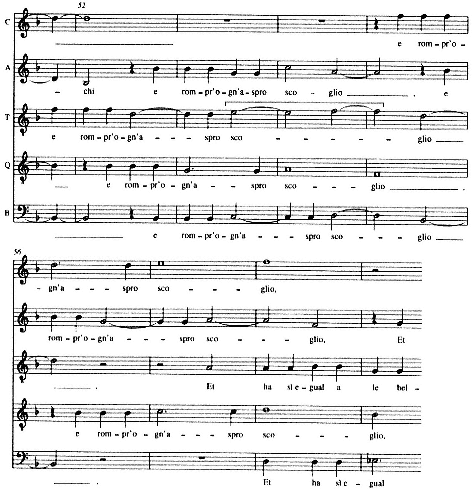
Ex. 15.
Willaert, Giunto m'ha Amor fra belle e crude braccia (Petrarch, no. 171), mm.
52-59; Musica nova (Venice, 1559), no. 11.
These kaleidoscopic effects do not diminish Willaert's ability to shape Petrarch's conceptual patterning in music, as the structural summary of Pien d'un vago pensier in Table 5 makes plain. The schemata of Table 5 necessarily give only a crude picture of the real articulative events in the piece, since the cadences, while intelligible contrapuntally as two-voice formations, are almost always obscured and enervated by the surrounding polyphonic activity of the other voices. Note, for example, that the first cadence, to the perfect octave c/C in tenor and bassus in m. 16, is thoroughly overlapped by multiple, varied assertions of the motive on "e fammi al mondo ir solo" throughout the upper registers. However clear-cut such a two-voice cadence may be, the overall impression conveyed is one of continuity. In a texture like this one, fine gradations in articulation can be projected through the relative strength of preparation and resolution. But such preparation and resolution are rarely unequivocal except at
| ||||||||||||||||||||||||||||||||||||||||||||||||||||||||||||||||||||||||||||||||||||||||||||||||||||||||||||||||||||||||||||||
the end of the prima or seconda parte or at exceptional rhetorical moments and, in any case, are always complicated by other factors — especially texture.
The next cadential gesture at the end of v. 3 (mm. 22-23) presents a different situation, related to the ubiquitous technique that Zarlino dubbed "fuggir la cadenza." The cadence is conspicuously prepared but its resolution is foiled as it moves from an intended penultimate sonority on a C-major triad to one on c-minor. The cadential cantus falls silent at its expected moment of arrival on ff at m. 24 (one of Zarlino's standard "evasion" techniques), replaced by a jarring cross relation, ee/e-flat, with the quintus.
Despite this constant undercutting, Willaert's complex cadential formations do not hinder the goal of supporting Petrarch's linguistic and thematic articulations.
Quite the contrary; they aid it by complementing Petrarch's verbal hierarchy with a musical one, at least within the subtle band of utterance Willaert's idiom allows. Willaert's Musica nova settings generally vary the degree to which cadences are made strong or weak through a judicious deployment of perfect and imperfect cadences, extravagant cadences, different sorts of evasions, and rests. In Pien d'un vago pensier Willaert varied articulative weight, modifying the number of cadential gestures successively deployed by shifting voice pairs for a given portion of text. Mild but calculated cadential repetition is key to such a strategy. By means of sheer repetition, Willaert strengthened the conclusions of each of the independent clauses that end the two quatrains (mm. 30, 32, 34, and 36; mm. 63, 68, 71, and 73) — even though the gestures taken singly are not especially strong — and in accordance with Zarlino's dictum that textual repetitions be limited to significant parts of a text. Cadences are also positioned carefully in different tessituras according to grammatical weight. Thus while the lower voices bury their cadence under continuous upper-voice melody when ending a mere dependent clause at m. 16, three of the four cadences that end the main clause of the first quatrain are exposed in the uppermost register (mm. 30-36).
Verse 12 shows how shrewdly Willaert coordinates these articulations with the main structural divisions of the sonnet. At this juncture, two striking cadences demarcate the poet's progress following the rhetorically crucial "Allor raccolgo I'alma." Though standing in formal isolation, prosodically unhinged, these words signal the poem's spiritual turning point. Willaert's setting highlights them with an independent melody and a turn to somewhat broadened rhythmic gestures. As the declamation slows, the semibreves allow the resonant a 's, o 's, and the double consonants to breathe, creating assonance in accented and unaccented syllables alike and a deceleration that marks at once the text's grammatical structure and its "grave" rhetorical character.[49]
The value of Willaert's reading is both immediate and contextual, since it sets up the musico-dramatic pacing of the remainder of the sonnet. The long phrases subsequently assigned to "e poi ch'i aggio / Di scovrirle il mio mal preso consiglio" (vv. 12-13) in order to span the enjambment contrast with the relatively short ones that have just been heard. Further, by returning to a predominant minim motion, the music resumes its insistent pace and starts to marshall the more bustling texture with which Willaert generally approached sectional endings. Willaert sustains both qualities through the final verse and heightens their rhetorical effects with a flood of closely spaced entrances for "Tanto le ho à dir," a new voice entering nearly every semibreve from mm. 116 to 123.
Willaert's organization of cadences supports these subtle interactions of meaning and prosody as much as it does grammatical weight. To consider how this operates,
[49] Willaert generally used this technique to distinguish the articulations between quatrains and tercets. See, for instance, the transitions from vv. 4-5 in L'aura mia sacra (m. 49) and Giunto m'ha Amor (mm. 39-40); and from vv. 11-12 in L'aura mia sacra (mm. 92-93) and Cantai, hor piango (mm. 96-97); Willaert, Opera omnia, vol. 13.
let us assume (with Zarlino) that a background modal conception underlies the madrigal's overall pitch plan. Zarlino assigned Pien d'un vago pensier to mode 11,[50] transposed Ionian authentic as conceived within Glareanus's twelve-mode numbering system, or mode 5 (authentic Lydian) in the traditional eight-mode system. Cantus, tenor, and quintus are all in authentic ranges, sextus, altus, and bassus in plagal. Willaert's setting concentrates cadences on the primary cadential degrees of the mode, the final F and confinal c. As shown in Table 5, the dependent clause of vv. 1-2 moves to the confinal, while three of the cadences ending the main clause in v. 4 (mm. 30, 34, and 36) form cadences on the final (albeit enfeebled by lower voices moving to the secondary degrees a, b-flat, and dd, respectively). In this mode all theorists of modal polyphony ranked the medial a just below the final and confinal in terms of cadential weight, and most named E, D, G, and b-flat as secondary degrees, permissible for internal cadences.[51] The remainder of the prima parte constructs a neat bit of tonal architecture, with a supporting the main clause that begins the second quatrain (m. 46) and a series of cadences emphasizing the final's antipole of C in the approach and conclusion of the octave. Not until the clause "Allor raccolgo l'alma" returns in v. 12 does Willaert cadence again on the final, and there he does so twice — once on the fifth ff/b-flat (m. 105), next on a perfect octave, f/F (m. 108).
Yet the point should be made again that none of these cadences comes close to halting or delaying the ongoing polyphonic motion. As a result of this continuity, everything takes place within a general gestalt of sameness, a contrapuntal feature of all Musica nova madrigals but a particular tonal characteristic of those in F-mollis. As if dabbing on empty canvases Willaert brightened them only with the lightest coloristic touches, in bursts like firefly shimmer, to conjure up vivid local moments.
Pitch color thus manages — and is managed by means of — two basic strategies: one involves choosing pitches gauged to help bring out hierarchic interrelationships of poetic syntax; the other involves accommodating the exigencies of these syntactic concerns to the subdued demeanor of the whole collection. At the local level of coloristic events Willaert pits relative stability against instability toward expressive ends, just as he does at the more architectonic level of cadential design. Just before restoring the final F in v. 12, for example, he presses B-flats and E-flats plaintively on the "cor doglioso" of the relative clause in v. 11. This turn to the flat side easily catches the ear, despite its mildness, because Willaert uses it only rarely. (Another set of E-flat inflections [mm. 19 and 24] follows the self-exodus narrated in v. 3, "Ad hor ad hor a me stesso m'involo.")
Flatted inflections often participate in larger processes of stabilization and destabilization that are regulated by Willaert's frequent use of circles of fifths. The preva-
[50] Istitutioni harmoniche, p. 333.
[51] For a summary of theorists' writings on this matter, see Bernhard Meier, The Modes of Classical Vocal Polyphony Described according to the Sources, trans. Ellen S. Beebe, rev. ed. (New York, 1988), pp. 101-22 (and for discussion of the cadence plan of a work by Wert in the same mode, pp. 158ff.).
lence of circle-of-fifth progressions offsets the potential that the melodies and counterpoint might be enervated by a certain aimlessness. In the passage just discussed, Willaert explores the flat side within fifth progressions in a way that reinforces poetic motion toward the syntactic/rhetorical goal: the E-flat triad of m. 18 moves backward through a circle of fifths all the way to one on a-minor (m. 21); and a briefer circle of fifths from a B-flat-major triad to one on d-minor (mm. 23-25) overarches the false resolution of the C-major sonority to c-minor.[52] This regulation of the flat side through the strong harmonic directedness of fifth progressions allows Willaert to convey the text in a way that appeals directly to the senses, instead of simply matching the poet's flight in a purely formal or iconic way.
Some of these circles of fifths do not project verbal meaning directly but simply help propel the counterpoint toward an imminent syntactic goal. In mm. 120-22, for instance, Willaert intensifies the repetitions of "tanto le ho a dir" by means of a fifth progression from a d-minor triad to one on B-flat. This is only the longest of several sequences of fifths that help strengthen the drive toward the final cadence (cf. mm. 114-16 and 125-26). In tonally static madrigals like this one, which oscillate along an F-C axis with little real movement toward an alternate tonal target, the sense of harmonic direction provides a vital source of kinetic energy.[53]
Willaert's coloristic techniques play another role in subtly resolving local syntactic ambiguities. To understand the interaction of tonal color and syntax at this local level, one needs to consider how Willaert copes with Petrarch's complex verbal constructions. Invariably, Musica nova settings parse words as prose rather than as verse, ostensibly linking proselike readings with dignity and gravity in the same way literary theorists like Daniello and Tomitano did in advocating proselike syntax for poets writing high lyric verse.[54] In these madrigals the juncture between words and music had thus fully shifted from the poetic line to the syntactic unit. As noted earlier, this meant that the enjambments favored by literati for sonnets ran rampant in Venetians' musical phrasings,[55] causing the textual units to fall out in unpoetic and highly asymmetrical arrangements.
Even this rule of thumb could not produce all the necessary solutions about how to parse a given text, however, since not all verbal constructions unequivocally suggested a single prose reading. Indeed, Pien d'un vago pensier includes one of the most ambiguous, Latinate lines Petrarch ever wrote, v. 8: "Questa bella d'Amor
[52] Cf. also the circle of fifths from the end of m. 96 to m. 98.
[53] Gary Tomlinson has noted this phenomenon as part of the pastoral topos employed by Wert, Marenzio, and Monteverdi, in Monteverdi and the End of the Renaissance (Berkeley and Los Angeles, 1987); see also Chap. 8 below, nn. 24 and 25.
[54] See Chap. 5 above, nn. 122 and 133.
[55] In addition to the comments on enjambment cited in Chap. 5 above, nn. 142-44, see also Torquato Tasso's praise of Giovanni della Casa's use of the technique in his "Lezione sopra Questa mortal vita, " discussed in Gary Tomlinson, "Rinuccini, Peri, Monteverdi, and the Humanist Heritage of Opera" (Ph.D. diss., University of California at Berkeley, 1979), pp. 55-57.
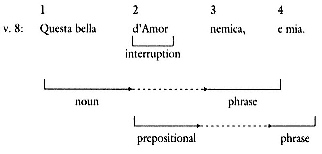
Fig. 1A
nemica, e mia."[56] Structurally, this is a line that evokes the mercurial quality of Petrarch's elusive lady. It rends the Petrarchan oxymoron on the beloved, the "bella nemica," with the intrusive "d'Amor" to form four disconnected grammatical units, as shown in Fig. 1a. Here the four constituents stand in a kind of chiastic relationship to one another, each of them one position removed from its proper neighbor. But the elements can also be considered in another way, as suggested in Fig. 1b. In this reading "questa bella" forms a complete and independent substantive, if a disarmingly casual one in Petrarchan discourse for reference to Laura. "Nemica" then counts as a second noun phrase troping "questa bella," and "d'Amor" a prepositional phrase defining simply "nemica." The possessive "mia," free-floating outside the main frame of the line, might be thought to define either "bella" or "nemica," or both, depending on how the reader perceives the line; its indeterminacy proceeds from the vagueness of the substantive, without which "mia" has no point of reference. Since Petrarchan commentators of Willaert's time seem consistently to have read the line as in Fig. 1a (as we will see Willaert appears to have done also), it seems fair to take this as our point of departure.[57]
The severed noun phrase of line 8 surprises, since even Petrarch's mannered norms did not usually allow for it. But the ambiguities thus created are a vital part of the line's rhetorical effect and its meaning. "Amor" is not only the intruder in the syntactic process but the culprit in the fractious vision of the poem as a whole. As hinted above, the witty dissociation of "e mia," combined with the line's lack of an unambiguous substantive, robs it of a clear grammatical affiliation and hence mean-
[56] For a fuller discussion of Willaert's syntactic strategies see my "Composer as Exegete: Interpretations of Petrarchan Syntax in the Venetian Madrigal," Studi musicali 18 (1989): 203-38, of which pp. 212-16 have been adapted for what follows. A broader appraisal of medieval and Renaissance concepts of syntax may be found in W. Keith Percival, "Deep and Surface Structure Concepts in Renaissance and Medieval Syntactic Theory," in History of Linguistic Thought and Contemporary Linguistics, ed. Herman Parret (Berlin and New York, 1976), pp. 238-53.
[57] Sixteenth-century commentators tended to restore the oxymoron with the paraphrase "Questa bella nemica d'Amor, e mia," with no comma after "bella" that would designate it a noun. See, for example, Sonetti, canzoni, e triomphi di Messer Francesco Petrarca con la spositione di Bernardino Daniello da Lucca (Venice, 1541), fol. 113; and Le rime del Petrarca brevemente sposte per Lodovico Castelvetro . . . (Basel, 1582), p. 312.
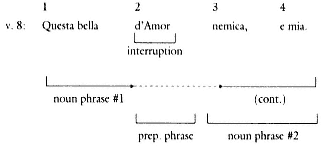
Fig. 1B
ing (my lovely one? my lovely enemy? mine and Love's?). The disorientation of "mia" comments on the slippery nature of the thing possessed; yet its dangling isolation, a structural means of semantic emphasis, accentuates at the same time the quality of possession.
Given Willaert's concern for linguistic coherence the line presented declamatory problems and perhaps inevitably invited multiple, fragmentary readings.[58] By offering a number of different fragments of the line Willaert was able to comment both on the nature of the fragmentation and on the grammatical interrelationships of the verse. Much of it he parsed in such a way as to unify the noun phrase "questa bella nemica": two outer voices initially present "questa bella" alone with a separate, lingering melodic figure, but immediately afterward all six declaim the verse in integral phrases up to the word "nemica." This bit of text, the one most frequently stated, fuses in a single melodic gesture the subject "nemica" with its qualifying adjective "bella." We might say that Willaert admitted the ambiguity and then resolved it: "Questa bella . . .," "Questa bella d'Amor nemica. "
In the tenor, by contrast, beginning in m. 62, Willaert linked the other disjointed verbal elements indicated in Fig. 1a by deploying a different textual fragment: "d'Amor nemica, e mia." This is the only time in this lengthy exposition when "e mia" joins directly any other portion of the verse, and the reason for it seems clear. Without the suspended adjectives "questa bella," no consolidation of the noun phrase (as obtained by ending with the word "nemica") is required. The phrase "d'Amor nemica, e mia" instead serves to unify words that function in essence as two prepositional phrases: "d'Amor" and "e mia" (that is, "d'Amor, e di me"). Now, for the only time in the whole passage, "e mia" is sung twice in a row (tenor, mm. 65-67) — repeated, that is, without first returning to an earlier part of the verse. Through this repetition and other isolated statements, Willaert took advantage of the line's grammatical self-sufficiency up to the word "nemica" to heighten the broken pathos that "e mia" inflicts on the octave's ending.
[58] For another example of varied parsing in Willaert's settings (of which there are many) see my comments on his Cantai, hor piango, e non men di dolcezza, vv. 1-2, in Chap. 9 nn. 41ff., below.
Just as telling as the many textual fragments that Willaert used here are those he avoided. Most important, the whole verse is never set to an unbroken melodic phrase. We should not underestimate the significance of this in a lengthy passage that provides so many diverse statements. Willaert seems to have considered presentation of the verse in a single phrase unintelligible, or insufficiently interpretive. Also, the words of the prepositional phrase "d'Amor" are invariably joined to the succeeding subject "nemica," as if one were a necessary rhetorical consequent of the other. Willaert's consistent linking of these words reduces the confusion created in the verse by the interjected "d'Amor" while preserving its descriptive role (this of-Love enemy).
To return, finally, to the question of tonal color, Willaert exploits the contrast of stable and unstable pitches to help underscore syntactic articulations. The dispassionate pitches F and C function as recurrent, if fleeting, points of repose for the words nemica and mia, words that conclude the severed syntactic units to which each belongs. The effect is striking at the two perfect cadences on C of mm. 63 and 71 and at the cadence on the perfect fifth g/C at m. 68. But it can also be perceived at numerous melodic markers. If we follow the soggetto in the cantus from m. 53 through the cadence in m. 63 and continue tracing the text repetitions in the cantus through to m. 73, we find an almost dogged insistence on ff and cc as points of departure (mm. 60, 63, and 70), arrival (mm. 60, 63, 69), and melodic accentuation (m. 57, 59, 65, and 66). When the soggetto appears in the altus in m. 64, its melodic line is anchored between F and c at mm. 68 and 71, respectively.
The way these pitches function tonally echoes the madrigal's placid opening exposition, especially in mm. 1-17, where F and C dominate the tonal space, undulating back and forth but essentially locked in tonal stasis. They form a striking contrast to the delicate E-flat inflections in the setting of v. 8, which instead suggest incompleteness and uncertainty. Willaert uses these accidentals to shade the text locally: they occur only on the syntactically open and ambiguous words "bella" and "d'Amor" — a pair of E-flats on the first syllable of "bella" in m. 56 and one on the first syllable of "d'Amor" in m. 62. In this way, both here and elsewhere in the madrigal, flatted inflections form restless counterpoises to more tranquil surrounding areas.
In singling out Pien d'un vago pensier for discussion I have tried to represent Willaert's private style at its most undemonstrative — which is to say its most typical. Where he might have opted for gripping contrasts or dramatic expressivity, Willaert instead kept to a subdued poetic reading. The paucity of all but the weakest articulation, the ubiquitous motivic variation, shifting textures, and kaleidoscopic shifts of vocal color yield a sense of continual, quiet unfolding that Willaert's discursive declamation does little to disturb. The constantly varied materials that produce such a dense contrapuntal web served, I have argued, to project the attitude of decorum advocated by Venetian literati. Beyond this, the sacred rhetoric Willaert adapted encoded the quality of reverence — a reverence that points outwardly toward the
unattainable woman, but covertly to a rarified discourse of self-contemplation and lyric creation.
It was thus precisely through this highly localized process of incessant, subtle variation, rather than a patchwork of contrasts, that Willaert's late madrigals were able to meet contemporary rhetorical ideals of decorum and variation. This localized instantiation of rhetorical principles is consistent with the particular way in which Bembo codified them. Recall that his dialectic of variazione took shape through the opposing qualities of gravità and piacevolezza, whose interactions he (and his followers) mostly illustrated in shadings of local events. At the level of the poetic line this meant contrasts of accents, phonemes and letters, elisions, and syllable lengths; and at the next higher level those of line lengths, rhymes, and rhyme schemes. As a rule Willaert departed from making delicate chiaroscuro effects through timbre, meter, and pitch only when his text embodied clear-cut oppositions that cried out for bald contrasts. One such instance, much-cited in modern literature, is the exposition of his six-voice Aspro core e selvaggio e cruda voglia (no. 265), whose opening two verses are particularly susceptible to dialectical opposition.[59]
Aspro core e selvaggio e cruda voglia A harsh, savage heart and cruel desire
In dolce, humile, angelica figura In a sweet, humble, angelic form
Willaert echoed the verses' natural declamatory rhythms by contrasting the choppy dissonance of the poet's charges in v. 1 with the graceful sdrucciolo accent of his encomiastic "angelica" in v. 2 (Ex. 16). The declamation of the first is martial, based on the tactus; much of the second gently syncopated. As Claude V. Palisca has pointed out, a wealth of linear and contrapuntal progressions also articulate qualities of gravità and piacevolezza. Major sixths moving to perfect fifths and parallel major thirds — both described by Vincenzo Galilei as justifiable transgressions of counterpoint rules for the sake of imitating the text — dominate the harmonic movement in the first verse, but disappear in the flatted environment of the second.[60] Verse 1
[59] See the discussions by Dean T. Mace, "Pietro Bembo and the Literary Origins of the Italian Madrigal," The Musical Quarterly 55 (1969): 78-80, Claude V. Palisca, Humanism in Italian Renaissance Musical Thought (New Haven, 1986), pp. 357-67, and Armen Carapetyan, "The Musica Nova of Adriano Willaert: With a Special Reference to the Humanistic Society of 16th-Century Venice" (Ph.D. diss., Harvard University, 1945), pp. 188 and 255-57.
[60] The rule violated is one making imperfect consonances go to the closest perfect ones. Palisca notes that Galilei drew attention to the device in his Fronimo dialogo, nel quale si contengono le vere, et necessarie regole del intavolare la musica nel liuto (Venice, 1568), p. 13: "Patisce secondariamente eccettione ne l'imitatione delle parole, come bene lo manifestò fra gl'altri eccellenti musici in piu luoghi il famoso Adriano, & particolarmente nel principio di quella sua dotta Canzone, che gia compose à sei voci, qual comincia. Aspro core, & et seluaggio & cruda voglia, dove passa piu volte (per esprimere con gratia tal concetto,) non Solo dalla Sesta maggiore alla Quinta ma da una Terza maggior à l'altra col mouimento congiunto, & piacendoui serverò à vn'altra volta il mostrarui maggiormente l'eccelentia di questo condimento della musica" ([This may be broken] in imitating the words, as the famous Adrian did (among other composers) in the beginning of that learned music he composed for six voices on the sonnet of Petrarch which begins Aspro core, e selvaggio, & cruda voglia. There several times, in order to express the subject with grace, he passes not only from a major sixth to a fifth, but from a major third to another by conjunct movement. I shall save for another time to demonstrate the excellence of this musical seasoning); quoted in Humanism in Italian Renaissance Musical Thought, pp. 357 and 362 n. 60.
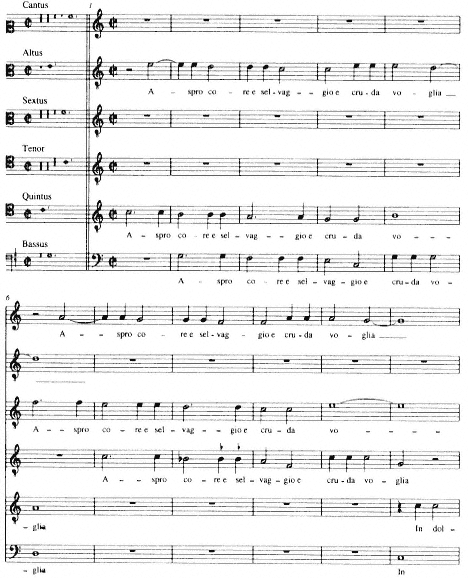
Ex. 16.
Willaert, Aspro core e selvaggio e cruda voglia (Petrarch, no. 265), mm. 1-22;
Musica nova (Venice, 1559), no. 14.
(continued on next page)
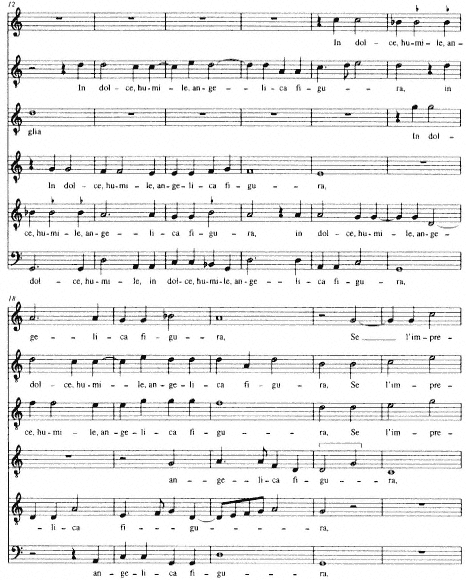
Ex. 16
(continued)
moves largely by melodic major seconds and major thirds and v. 2 by minor seconds and thirds and minor sixths, thus complementing the first verse's consonantal clusters and the liquids of the second (and recalling Zarlino's injunctions in Part IV, Chapter 32). Palisca also notes the tendency of the bass to move up by fifth and down by fourth for v. 1 and vice versa (down by fifth and up by fourth) for v. 2, tendencies Galilei associated with happiness, excitation, virility, and naturalness on the one hand and sad and subdued effects on the other.[61]
Willaert's interest in such dichotomies may seem clear in this instance, but it is rare that his Musica nova settings conform so straightforwardly to Bembist principles. Only three other cases, all again mainly notable for their exordia, are as striking in this respect as Aspro core. These include the pair of six-voice settings, I piansi, hor canto, che'l celeste lume and Cantai, hor piango, et non men di dolcezza ,[62] and the seven-voice Liete e pensose, accompagnate e sole.[63] Both of the first two begin with vivid antitheses that Willaert matched with madrigalisms: florid upturned melismas for singing and doleful sustained notes for weeping. In I piansi the image of weeping also invites a chain of suspensions (a virtual requirement at midcentury), here realized in varied entries of a stepwise descending motive alternating on arsis and thesis. (Quite unusually Willaert delayed the entrance of "hor canto" all the way until m. 9 and with it the establishment of the minim surface rhythm, which normally prevails after the first measure or two.)
The third setting that plays obviously with this sort of musical dialectic again embodies dualities codified by Bembo, especially in its octave.
"Liete e pensose, accompagnate e sole, "Happy and sad, in company and alone,
Donne che ragionando ite per via: Ladies who go talking by the way,
Ov'è la vita, ove la morte mia? Where is my life, my death?
Perché non è con voi com'ella sòle?" Why is she not with you as she is wont to be?" 4
"Liete siam per memoria di quel sole, "Happy are we in thinking of that sun;
Dogliose per sua dolce compagnia We are sad because we lack her company,
La qual ne toglie invidia et gelosia Which envious jealousy takes from us,
Che d'altrui ben quasi suo mal si dole." Grieving at another's good as if at its own harm." 8
[61] See Vincenzo Galilei, Dialogo della musica antica, et della moderna (Florence, 1581), p. 76.
[62] As in Petrarch's Canzoniere, the Musica nova places them side by side (though in reverse order). Discussions of this pair in the secondary literature can be found in Einstein, The Italian Madrigal 1:335-37; Willaert, Opera omnia 13:iv and v; Carapetyan, "The Musica nova of Adriano Willaert," pp. 164, 188, and 259-60; and Howard Mayer Brown, Music in the Renaissance (Englewood Cliffs, N.J., 1976), pp. 200-202. On Cantai, hor piango see also Bernhard Meier, "Rhetorical Aspects of Renaissance Modes," Journal of the Royal Musical Association 115 (1990): 183-84.
[63] Opera omnia 13:108-14. Liete e pensose is one of the two madrigals (along with Aspro core ) singled out by Mace for discussion ("The Literary Origins of the Italian Madrigal," pp. 80-83). Among the many other discussions of the madrigal are: Erich Hertzmann, Adrian Willaert in der weltlichen Vokalmusik seiner Zeit: Ein Beitrag zur Entwicklungsgeschichte der niederländisch-französischen und italienischen Liedformen in der ersten Hälfte des 16. Jahrhunderts (Leipzig, 1931), p. 53; Carapetyan, "The Musica nova of Adriano Willaert," pp. 118, 148, 185-86; Einstein, The Italian Madrigal 1:339; Willaert, Opera omnia 13:v; Helga Meier, "Zur Chronologie der Musica Nova Adriaen Willaerts," Analecta musicologica 12 (1973): 78; B. Meier, The Modes, pp. 126-28, 415; and David Alan Nutter, "The Italian Polyphonic Dialogue of the Sixteenth Century" (Ph.D. diss., University of Nottingham, 1978), 1:55.
These were lines ripe for the madrigalist's picking. Throughout the octave positive sentiments are keyed to the bright vowels e and i ("liete" and "vita," as well as the more neutral a , as in "accompagnate") and gloomier ones to the dark vowel o ("pen-sose," "sole," "morte," "dogliose"). Some of the contrasting terms are set in parallel structures that help tag rhythmically both meaning and sound: in v. I "liete" and "accompagnate" pair up as the first and corresponding terms in each syntactic entity and "pensose" and "sole" as the second — the second half of the verse thus echoing the first.
By articulating the syntactic inflections with rests and providing certain brightvoweled words with rising melodies and dark-voweled words with descending ones, Willaert intensified such parallelisms, as seen in Ex. 17. The four-voice group assigned to the first quatrain is divided into four sections, essentially one for each adjective. Willaert distinguished each through the contrast of major and minor intervals, both vertical and linear, in the uppermost voice: the major chords G and C and a melodic major second fall on "liete" and the minor chords a and d and a prominently accented melodic minor second, f to e, on "e pensose." Thereafter the "morte"/"vita" antithesis of v. 3 is expressed through similar means and further set off by parallel melodic motives in the altus — three repeated d's turning upward on "vita," downward on "morte."
Verse 5 summarizes the diverse syntactic and sentimental elements of the initial quatrain. By transferring to its outer limits both the words flanking v. 1 — "liete" and "sole" — Petrarch clarified their semantic relationship. The ladies' metaphoric recollection of Laura as that "sole," still resonating with its initial adjectival meaning, reminds the informed reader that she represents inseparably both happiness and loneliness. The new context of "liete" and "sole" in v. 5 thus enriches the words' meaning and consolidates them syntactically. As "Liete e pensose, accompagnate e sole" is recast as: "Liete siam per memoria di quel sole," that same "sole" which first conveyed desolation becomes, after the triple pun, a metaphor for the beloved who "sole" (both "alone" and "like the sun") in her radiance can produce happiness. Willaert's setting of v. 5 reflects this consolidation of symbol, syntax, and sense by delivering it in a single phrase, uninterrupted save short rests by cantus and sextus. It also reinterprets the final a-minor chord of v. 1's "sole" (m. 8) as A-major for that of v. 5 (m. 41). Moreover, the sextus and tenor, in mimicking the opening melodic material of septimus and altus, strengthen the correspondence between this verse and the first, helping to reinforce its special role in the octave.
I have touched on these four madrigals not only because all four trade in what are for Willaert uncommonly extroverted exordia, but because they have been the works most often cited from the Musica nova. In an important sense, they have formed the basis of widespread conceptions about Willaert's style. Their exemplary status in the musicological literature has lent support to certain representations of
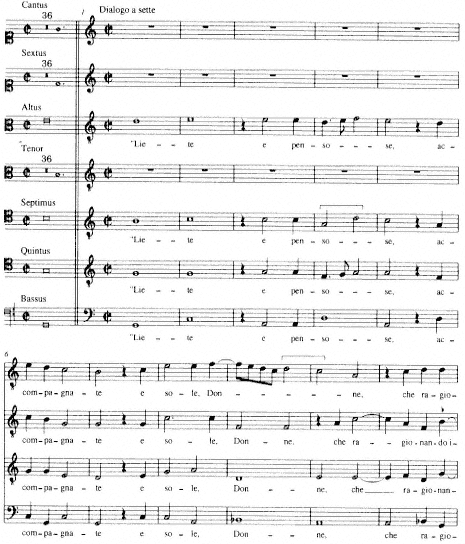
Ex. 17.
Willaert, Liete e pensose, accompagnate e sole (Petrarch, no. 222), mm. 1-42;
Musica nova (Venice, 1559), no. 23.
(continued on next page)
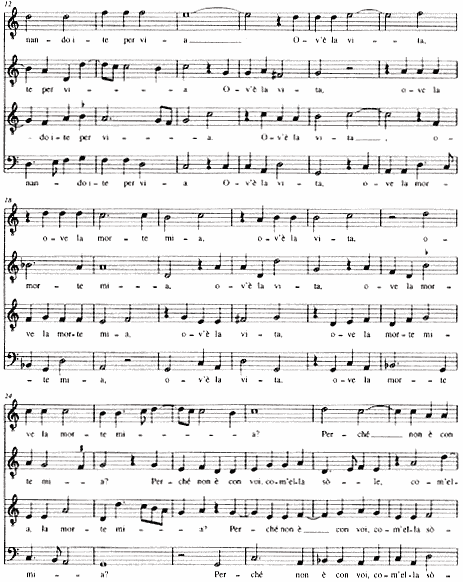
Ex. 17
(continued)
(continued on next page)
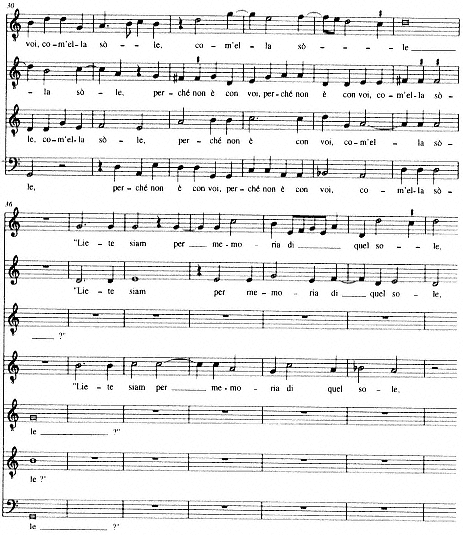
Ex. 17
(continued)
Willaert's new style as expressively vivid and given to musical symbolism, a representation first made by Gustave Reese. In asserting this, Reese isolated in the encyclopedic preserves of Music in the Renaissance only one tiny passage from the collection, a brief melisma on "cantando" from the otherwise archly spare Mentre che 'l cor.[64] His account of Musica nova style antedated the cross-disciplinary thinking that has since linked Willaert's madrigals to Bembo's ideas; it fell in better with teleological portrayals of madrigalian developments that sought to show the genre's increasing skill at mimesis over the course of the century. Like other such portrayals, a baldly mimetic approach seemed to offer the only tangible evidence of music's growing bond with words. It is not surprising that Reese had little else to say about the collection, since the reified textual-motivic links he wished to exemplify had in reality no prominent place in it.
Subsequent accounts have refined thinking about this repertory, yet something of the literalist impulse that guided Reese seems to underlie the expectations that have determined not only how we interpret but what we interpret — which examples have been chosen for close readings. Implicitly, at least, this literalism seems also to have shaped conceptions about the sorts of factors that must have governed Willaert's own readings, especially about how he realized Bembo's ideas: hence the censure, especially of Willaert's stark melody and undifferentiated pacing, that so often alloys praise of Willaert's late music, and the worrying over its lack of contrast.[65] Yet if, as I have insisted, strong juxtapositions were anathema to a Bembist idea of style, then Willaert's expressive reticence should cause neither surprise nor disappointment. I would view his subtly varied soggetti, plain rhythm, modest melody, and continuous musical fabric instead as carefully marshalled participants in his musica nova, a secular music intended to have no precedent or equal in weight and restraint. Willaert's personal conception — shared by his patrons, performers, and listeners — of the Musica nova as a monument to a newly conceived secular genre of the highest order seems clear from any number of features, both internal and external, that I have discussed: its compendious nature including four-, five-, six-, and seven-voice works, its mixing of madrigals with motets, its almost exclusive setting of Petrarch's poems, and its setting of complete sonnets.
Even those works by Willaert farthest from the Musica nova, his canzoni villanesche, seem to confirm the idea that his serious madrigals emerged from a
[64] Rev. ed. (New York, 1959), p. 324.
[65] See Edward E. Lowinsky, who suggests that humanistic demands for perfect declamation were the culprit hindering Willaert's ability to write good melodies: "Willaert's music has no easy appeal. Despite its masterly construction and notwithstanding its virtues of conciseness and elegance, its richness in harmonic color, its unexcelled adaption of the text, its variety of rhythmic and metric structure, it has a certain heaviness, hard to define, rooted perhaps in the absence of a true melodic inspiration. Yet the much freer flight of melody in his four-part ricercari suggests that the exigencies of a humanistically impeccable text setting in all the voices of a polyphonic complex of four, five, six, and more parts worked as a serious impediment to the free unfolding of melody" (Medici Codex 1:80). Similar reservations are voiced in Brown, "Words and Music," p. 228, and Carapetyan, "The Musica Nova of Adriano Willaert," pp. 115 and 147.
Bembist, hence Ciceronian, conception of stylistic propriety.[66] His conscious sense of purpose is evident from the way he codified the lighter style and segregated it (with help from Venetian printers) in separate publications. Indeed, the wholesale bifurcation of secular music into discrete genres, high and low, in Venetian musical production of the 1540s provides one of the clearest signs that Willaert's decorous fashioning of the madrigal was no failure of inspiration but one of the most concerted acts of Ciceronianism to emerge from early modern Venice.[67]
[66] The point is mentioned in Brown ("Words and Music," p. 229), who suggests that diverse genres in the music of Willaert and his students reflected Bembo's classical advocation of different stylistic levels. See also James Haar, who discusses the concern for genre in the period of Bembo's influence in Essays on Italian Poetry and Music in the Renaissance, 1350-1600 (Berkeley and Los Angeles, 1986), pp. 117-18; and idem, "Self-Consciousness about Style, Form, and Genre in 16th-Century Music," Studi musicali 3 (1974): 219-31; and Nino Pirrotta, "Willaert and the Canzone Villanesca ," in Music and Culture in Italy from the Middle Ages to the Baroque: A Collection of Essays (Cambridge, Mass., 1984); p. 179.
[67] The argument laid out in Michèle Fromson's "Themes of Exile in Willaert's Musica nova, " JAMS 47 (1994): 442-87, first came to my attention as this book was in press. Fromson's study contributes to our understanding of the religious background of Florentine republicans but reduces the multivalent cultural geography in which the Musica nova evolved to a single Florentine solution, reading the print's motet and Petrarchan sonnet texts as having registered solely in Florentine terms. I perceive a Florentine accent in Rore's first book but much less of one in Willaert's Musica nova, and I would question whether the romantic narrative of "heroic struggle" and "suicide" (pp. 465-66) that Fromson imposes on Florentine exiles (cf. p. 29 above) can be readily made to fit Neri Capponi, who is in fact the only known Florentine patron of the print. The crucial evidentiary basis of Fromson's thesis is the claim that Willaert's motets and madrigals evoked the Florentines' situation by quoting chants linked to loss and exile, but it is useful to remember here that Willaert's whole modal-melodic language was chant-based and that his melodic style in any case avoided distinctive motives.